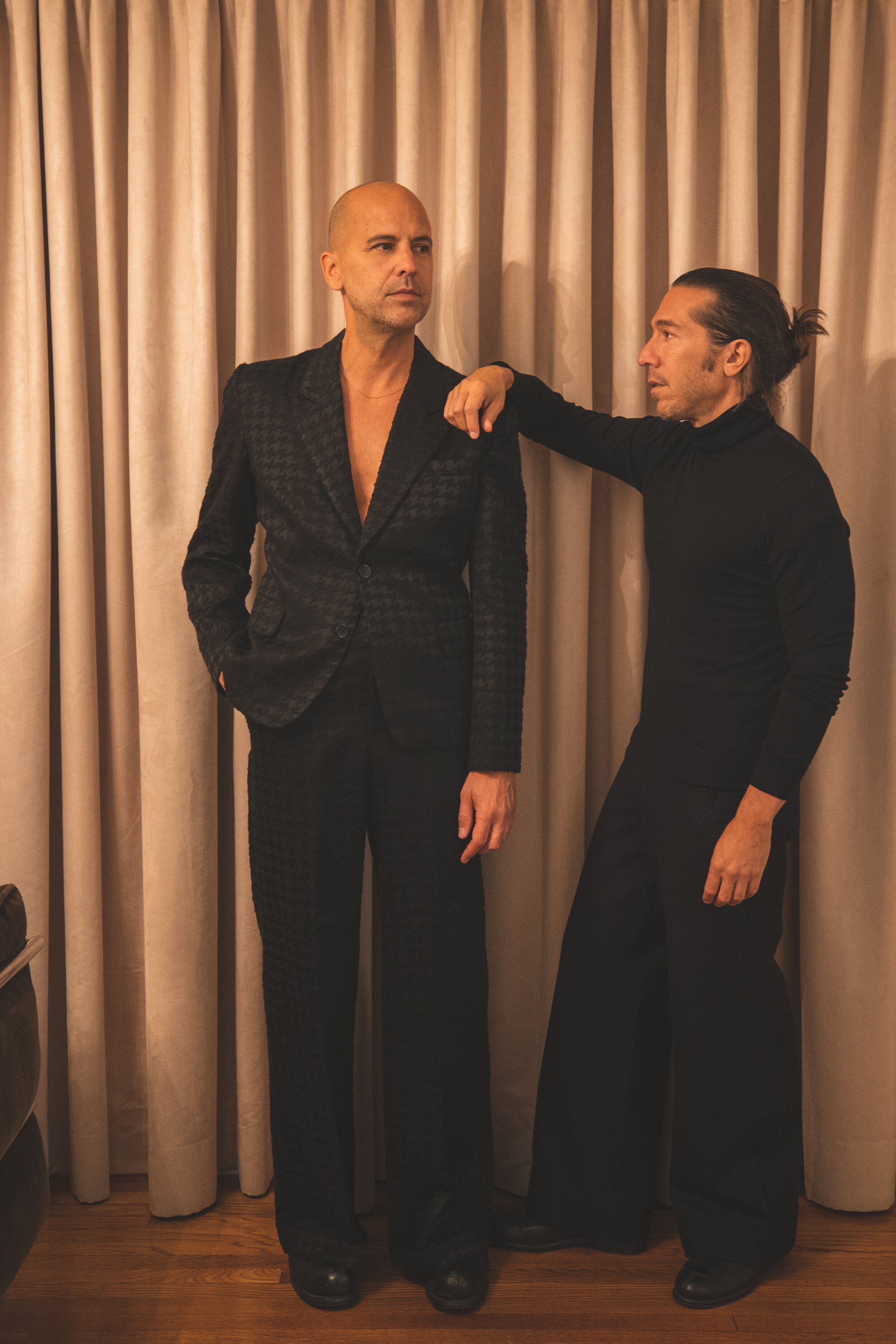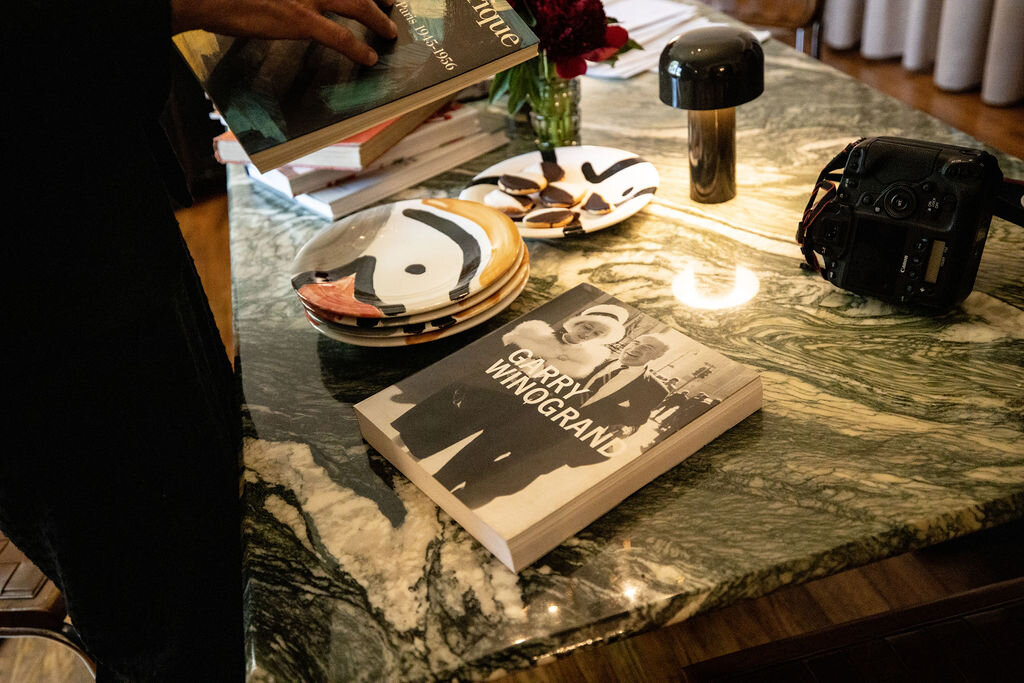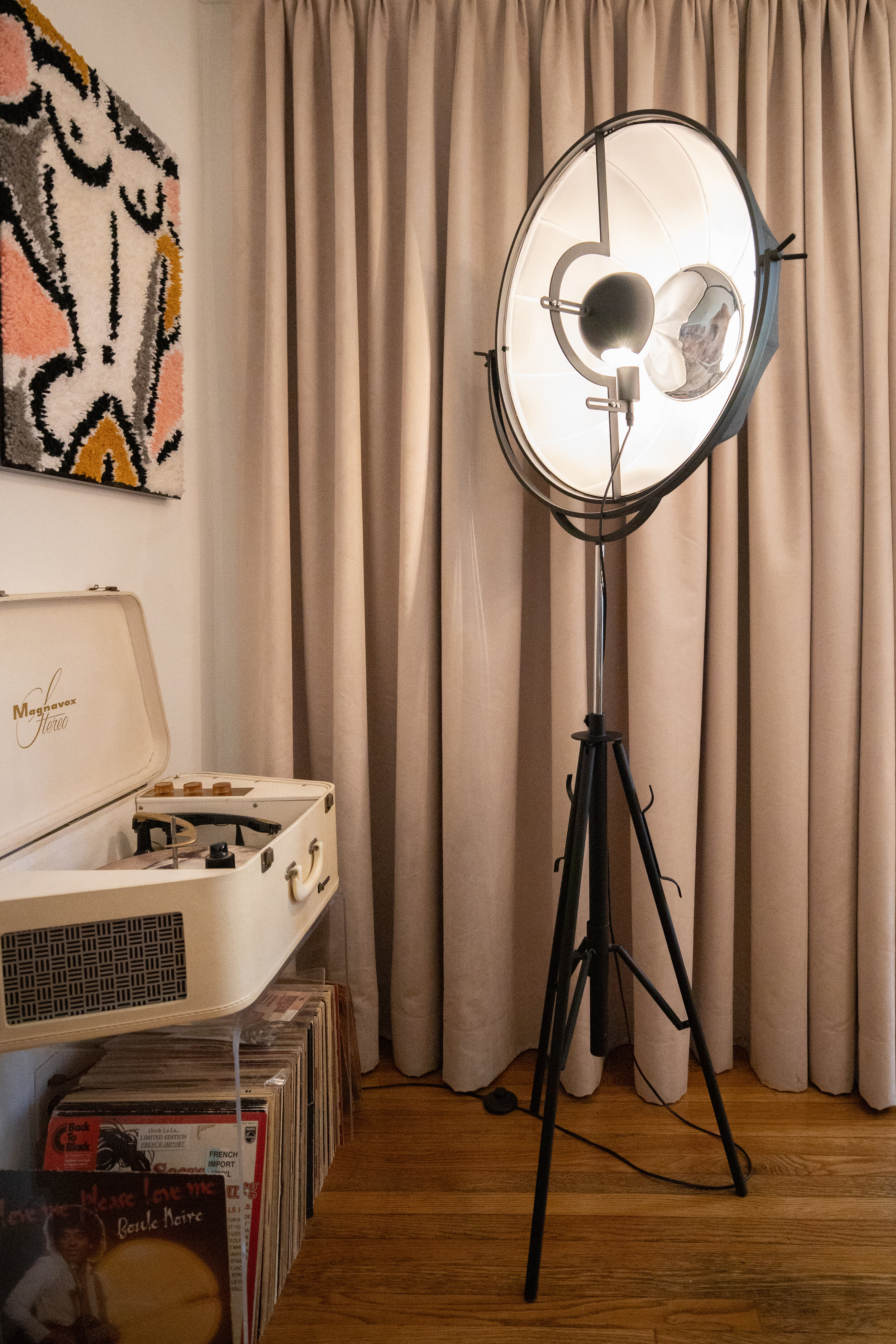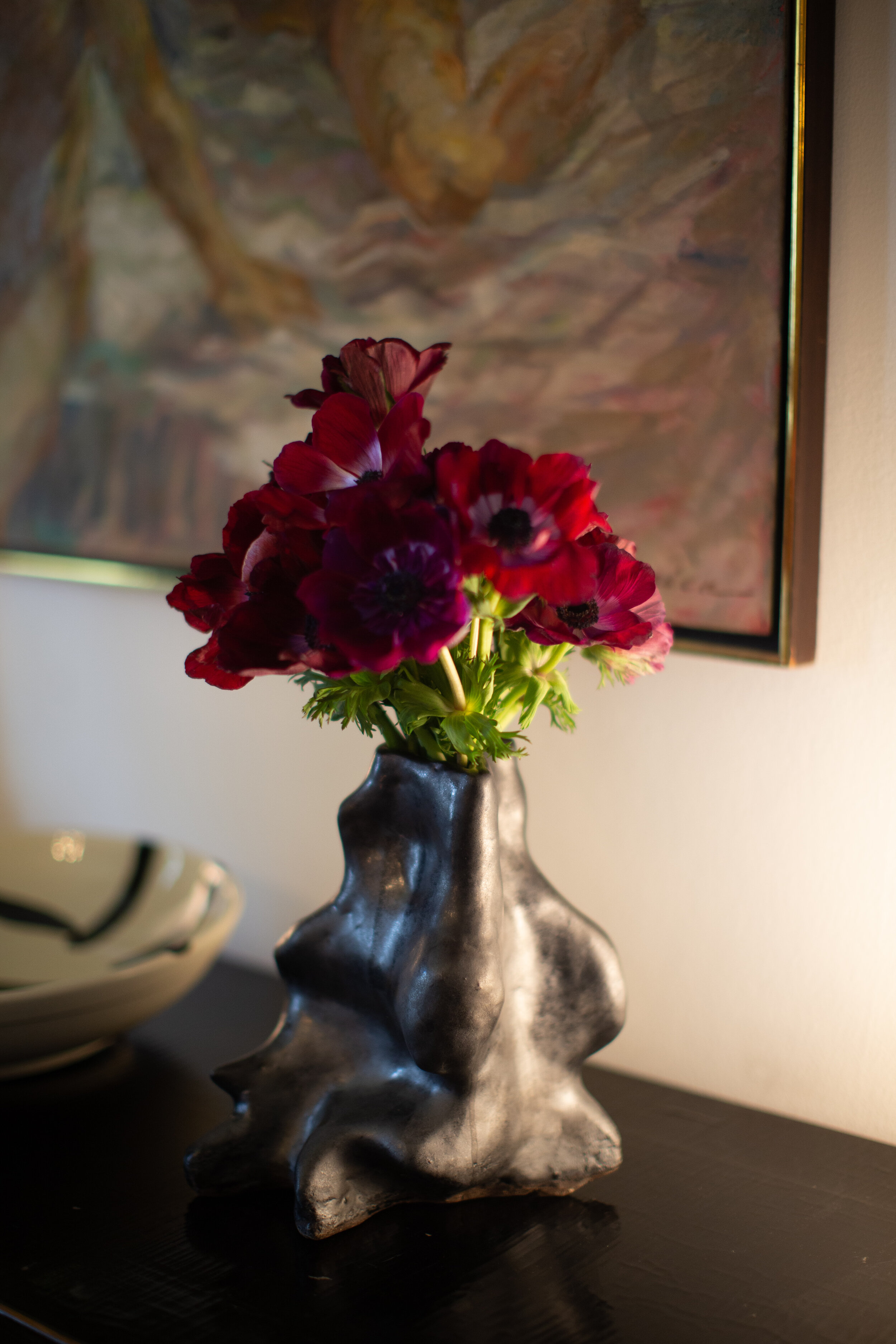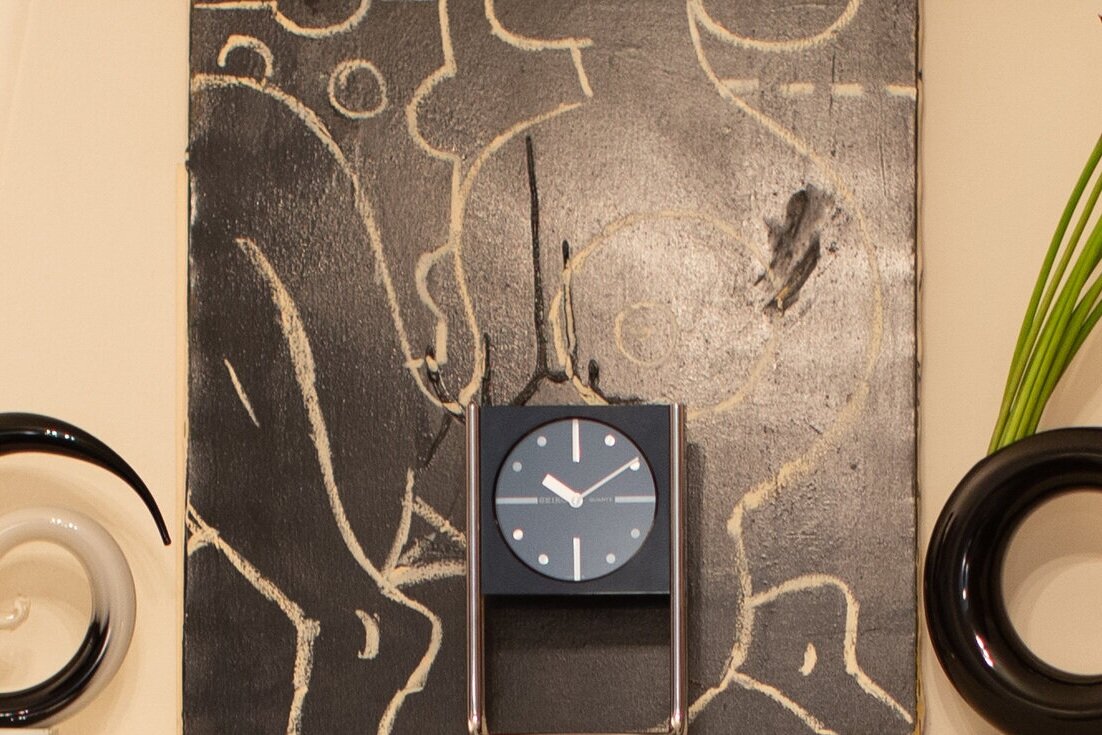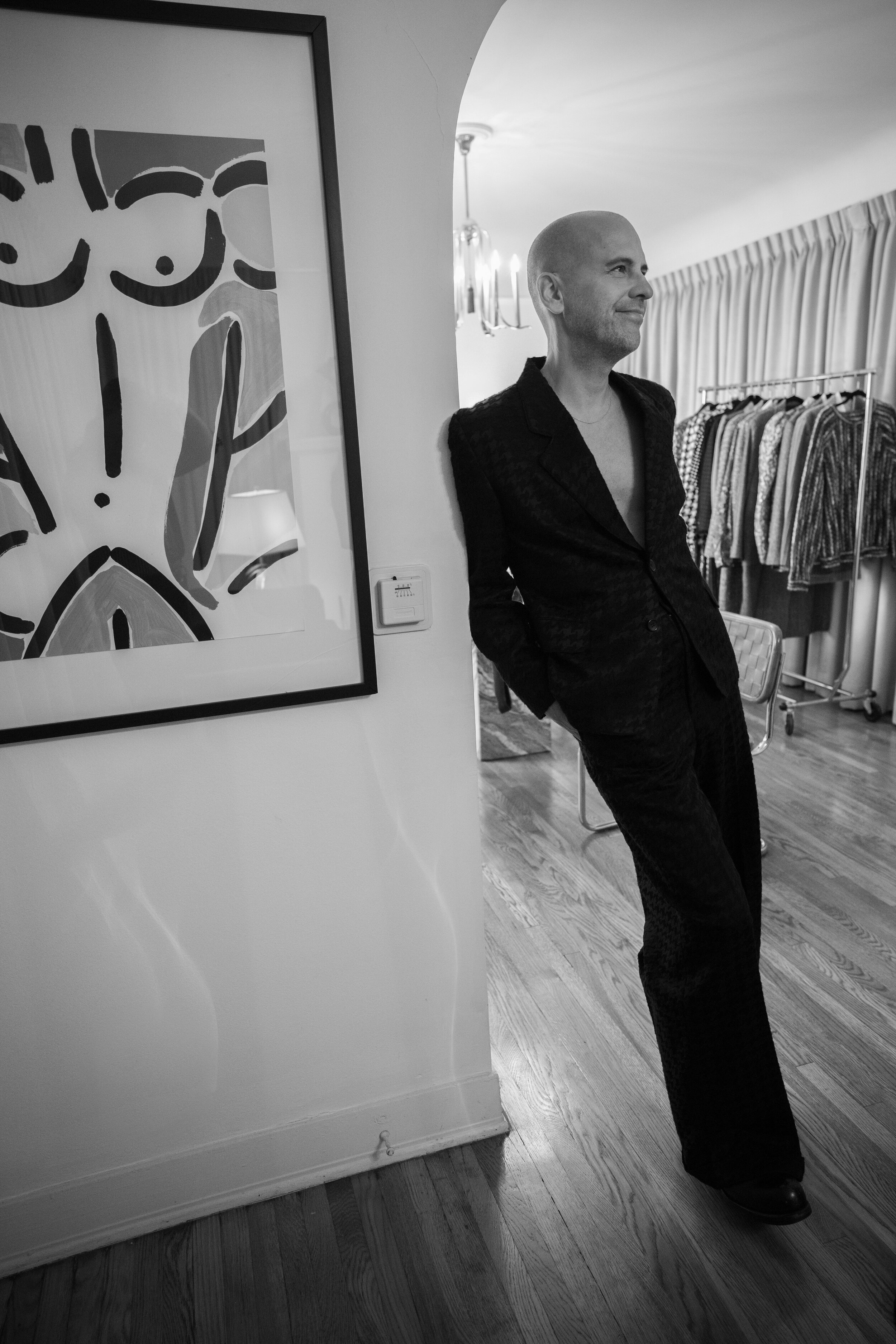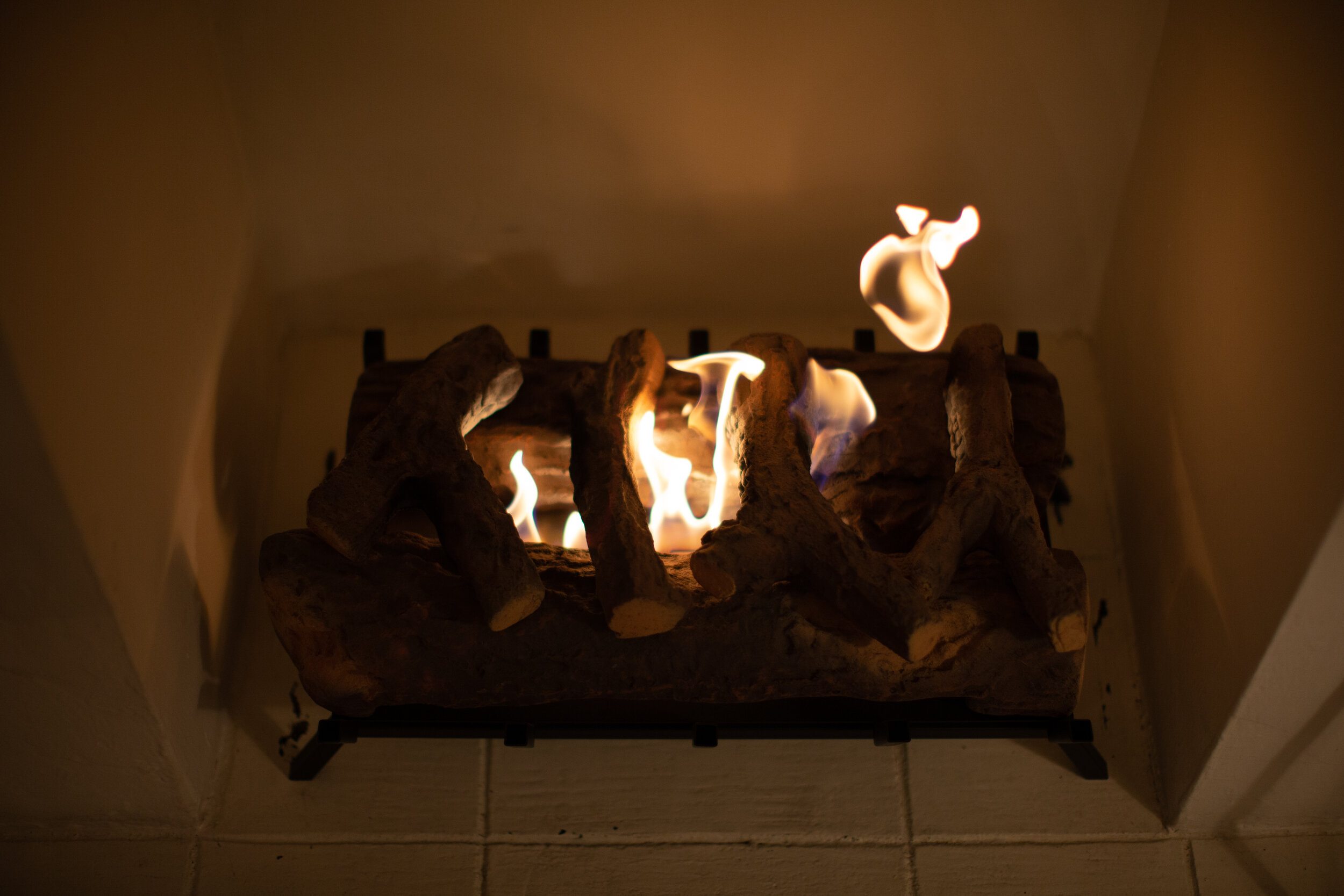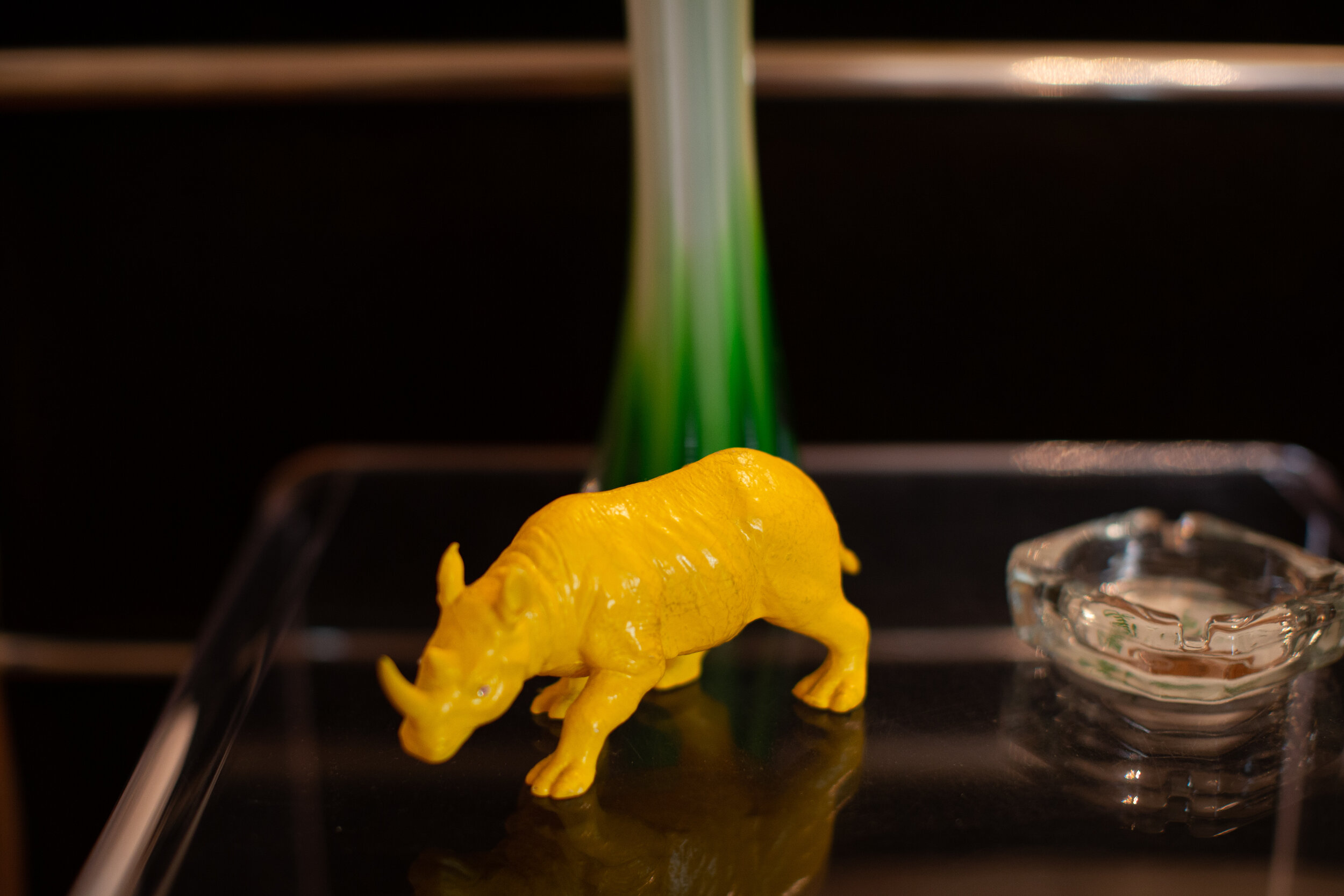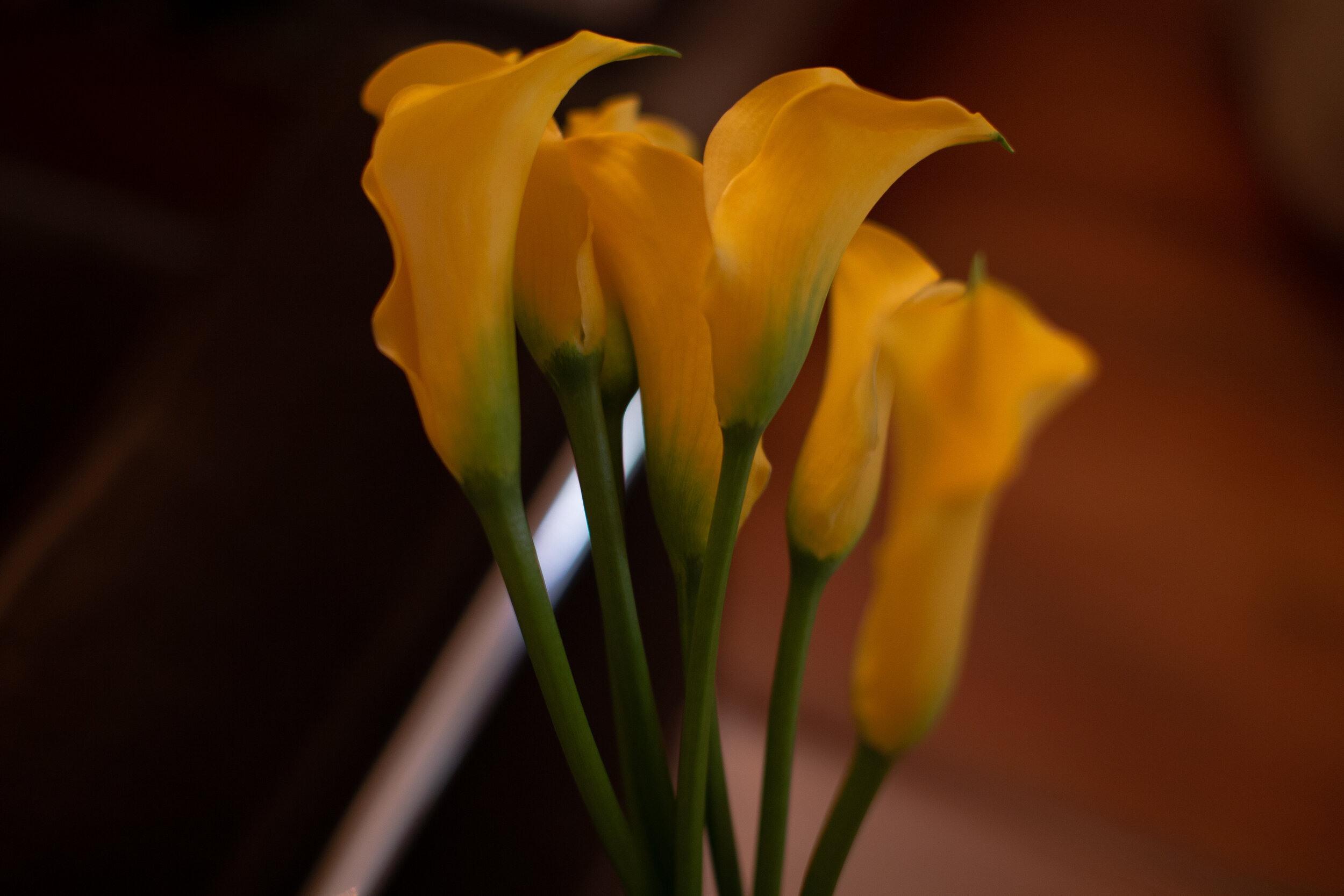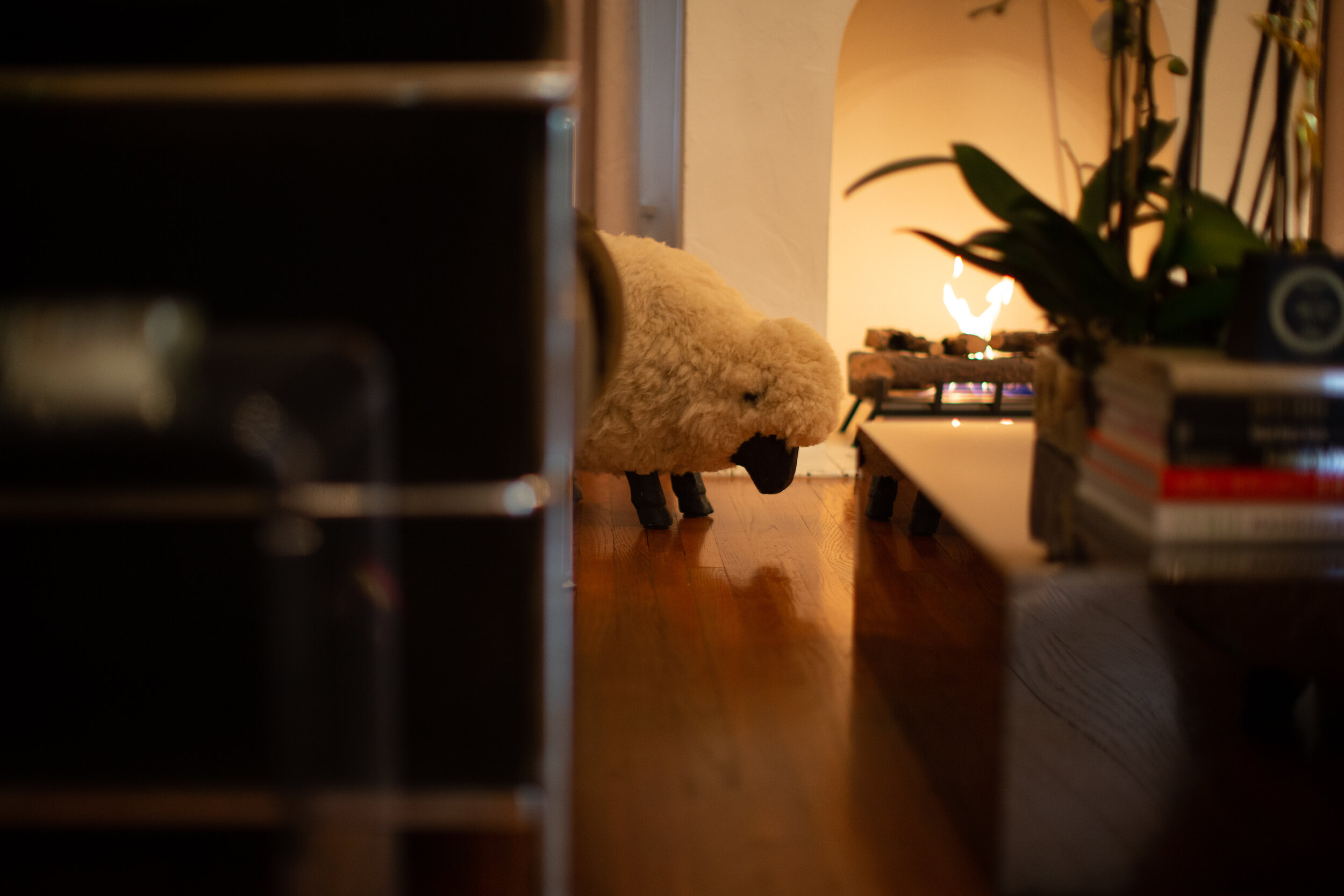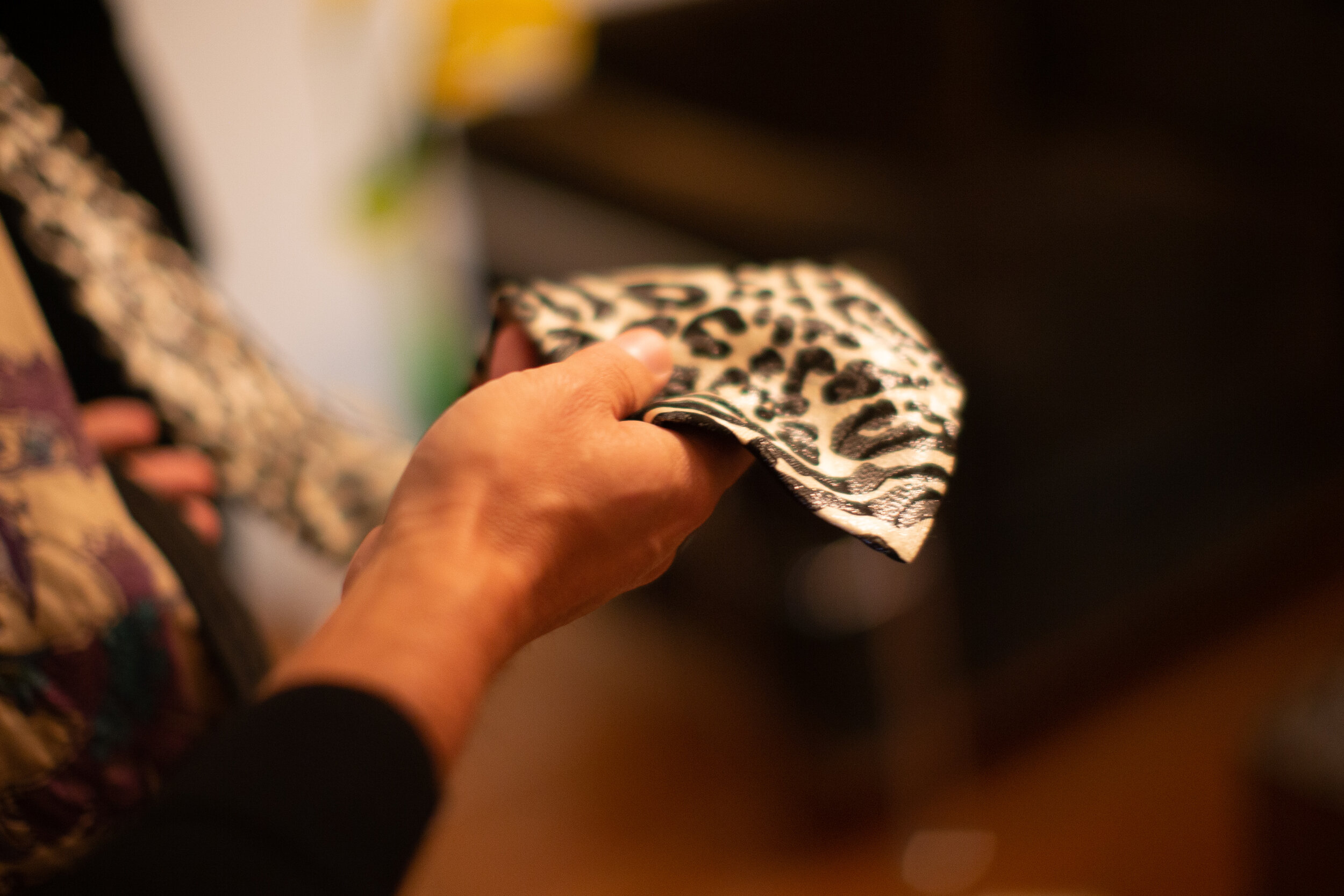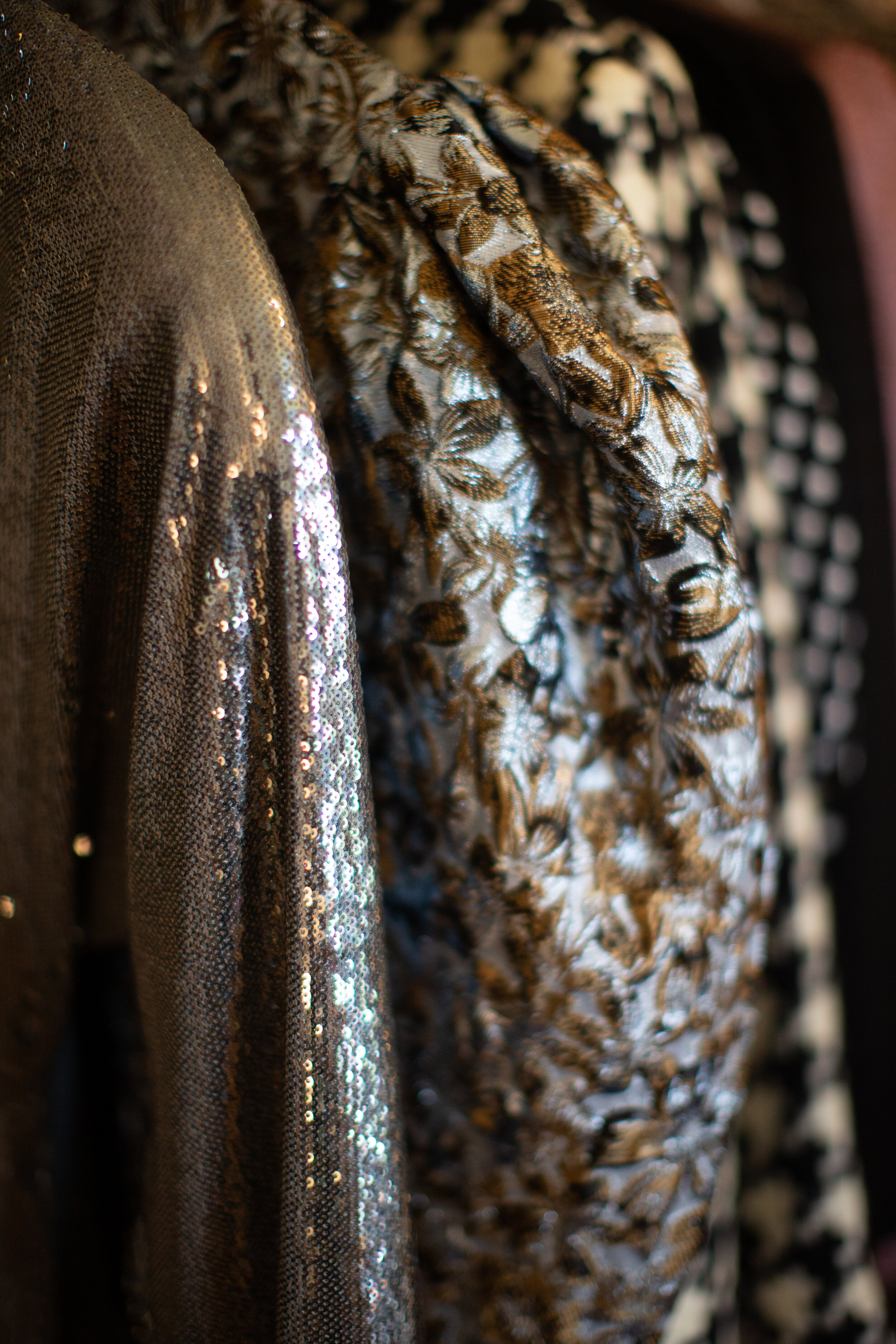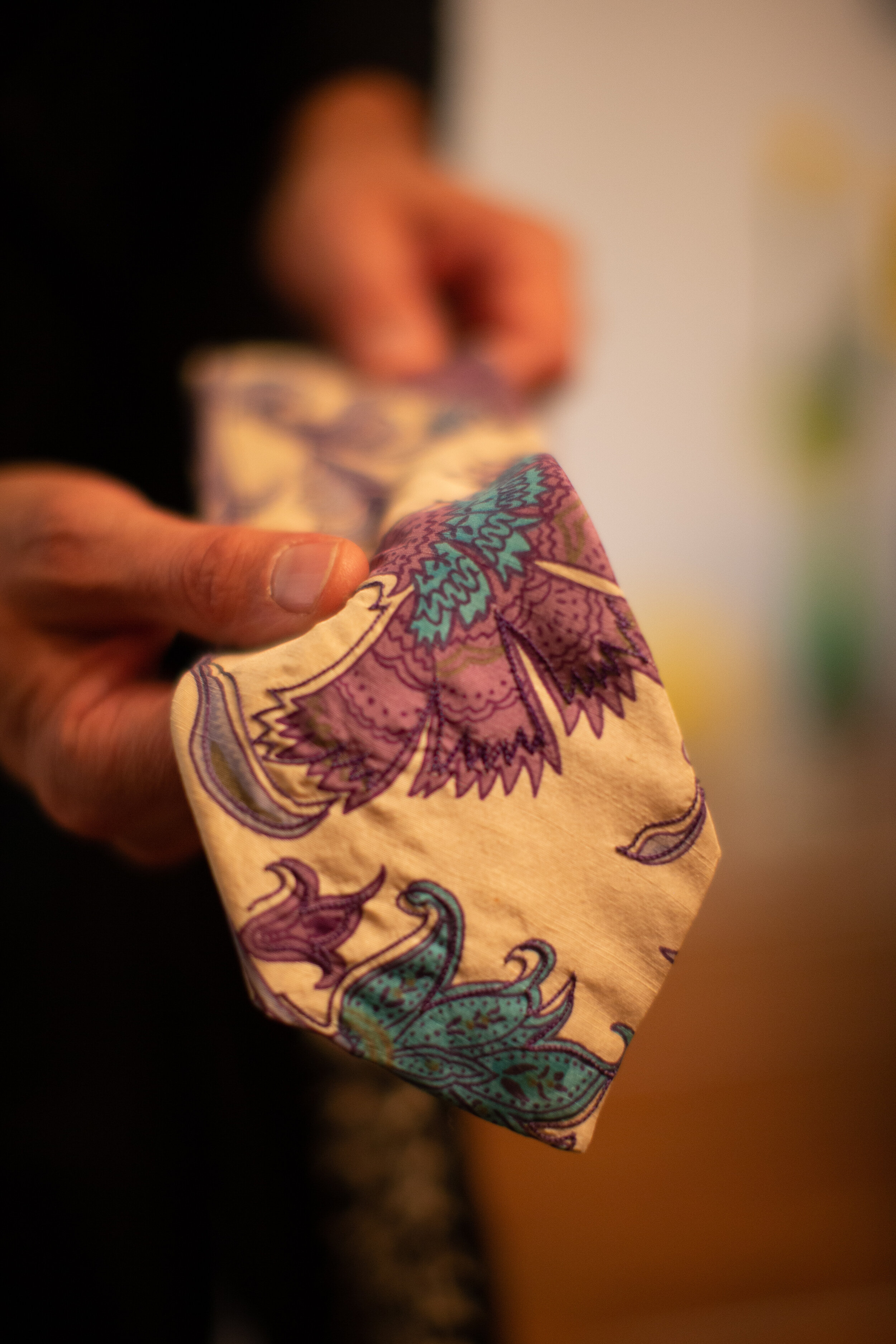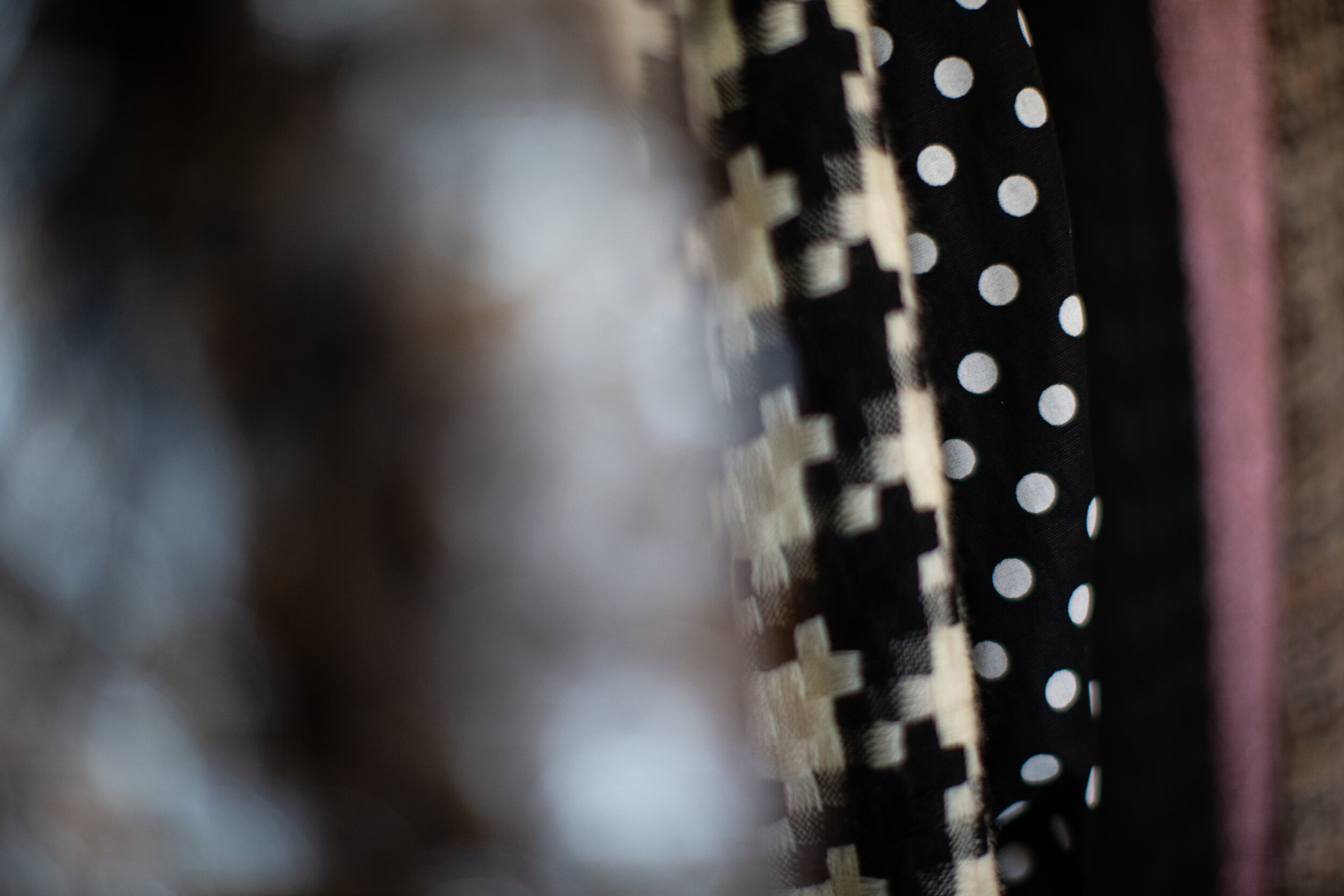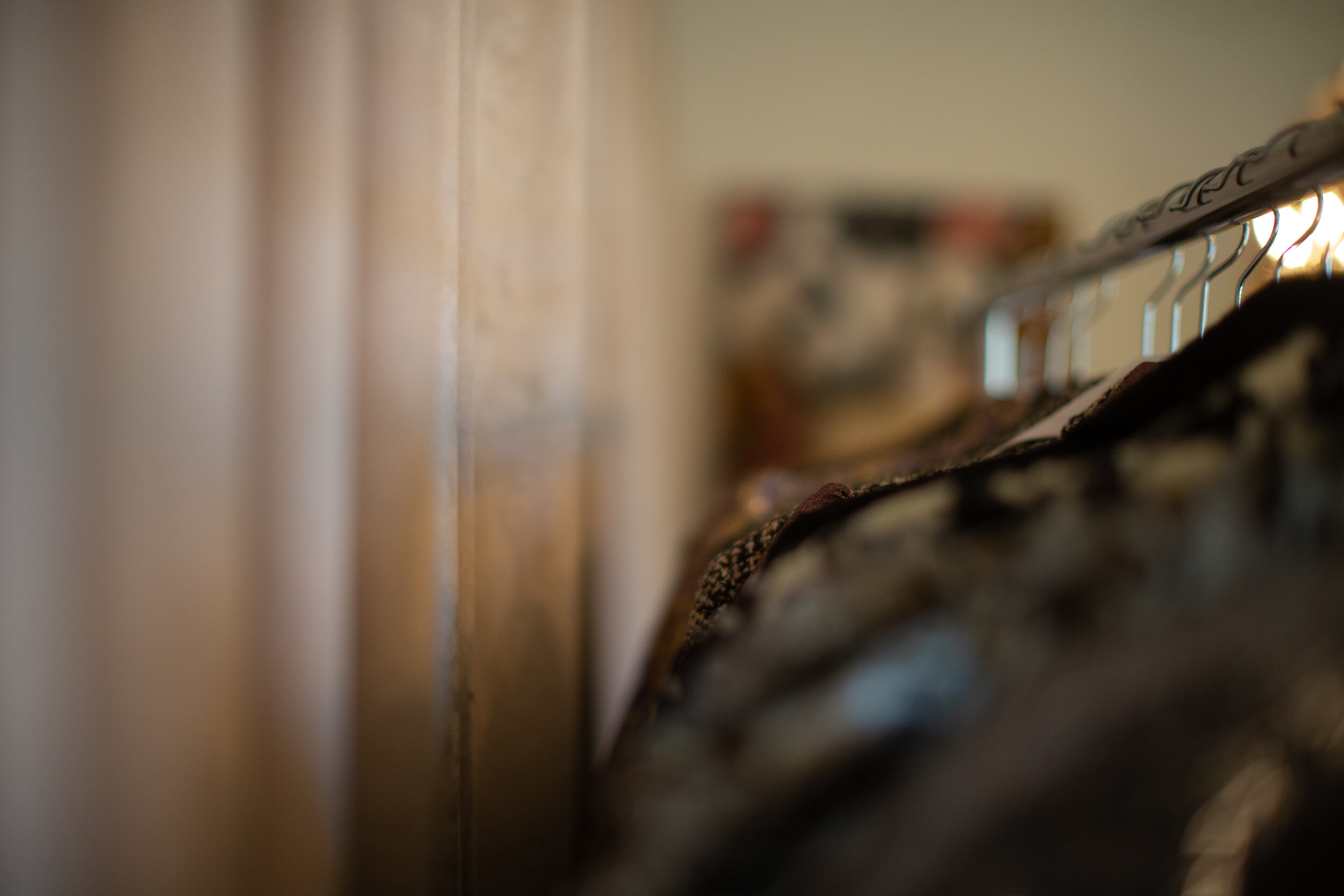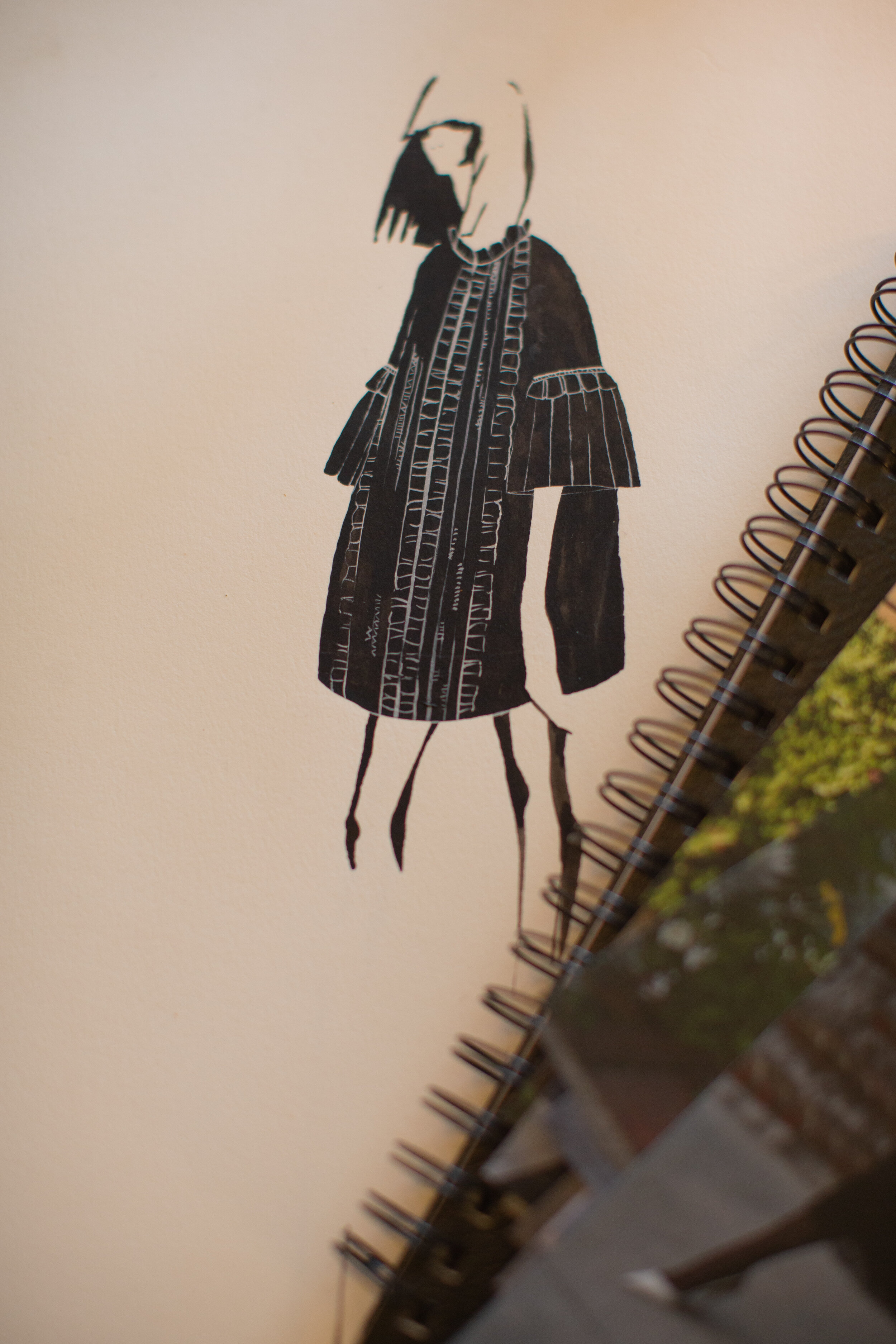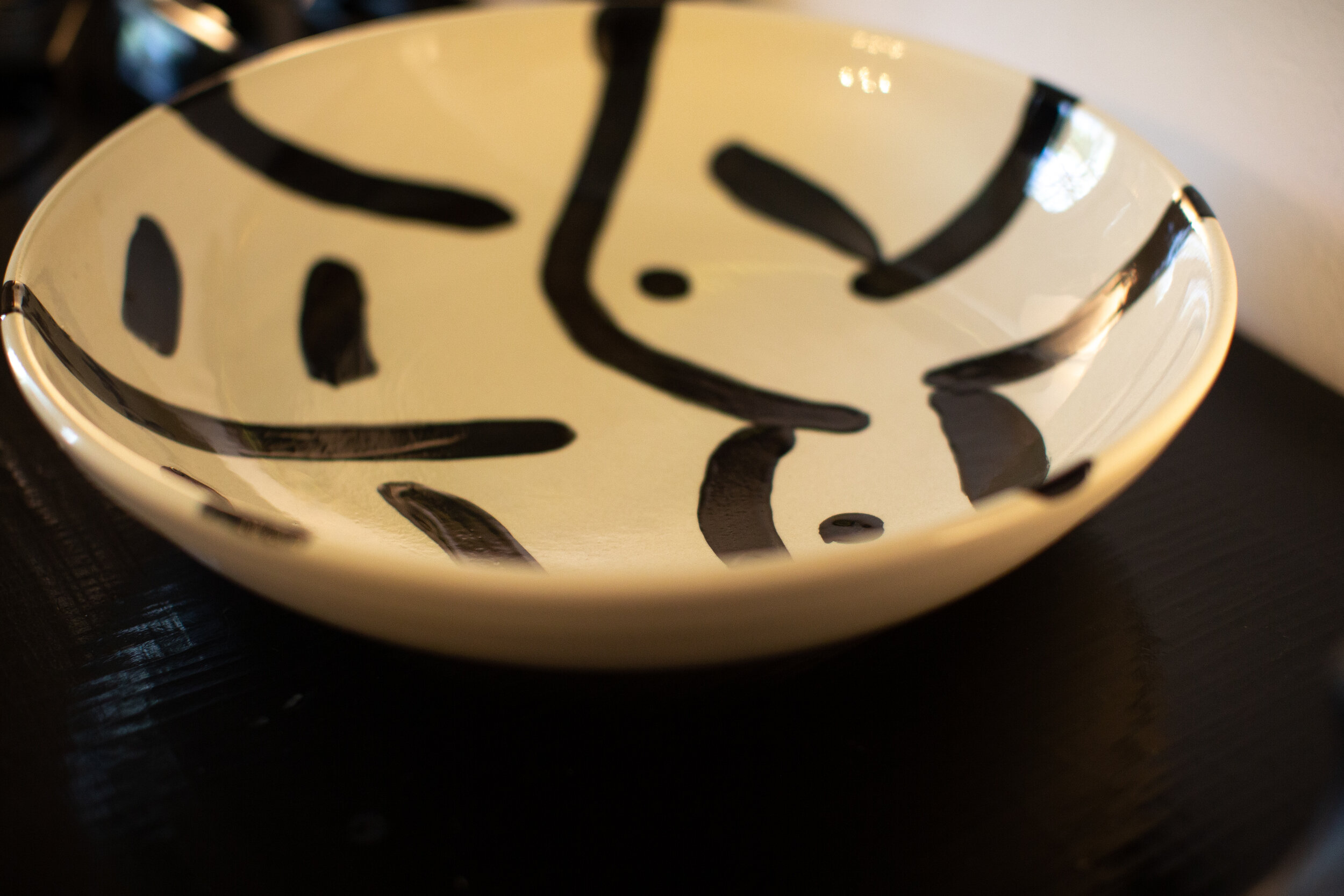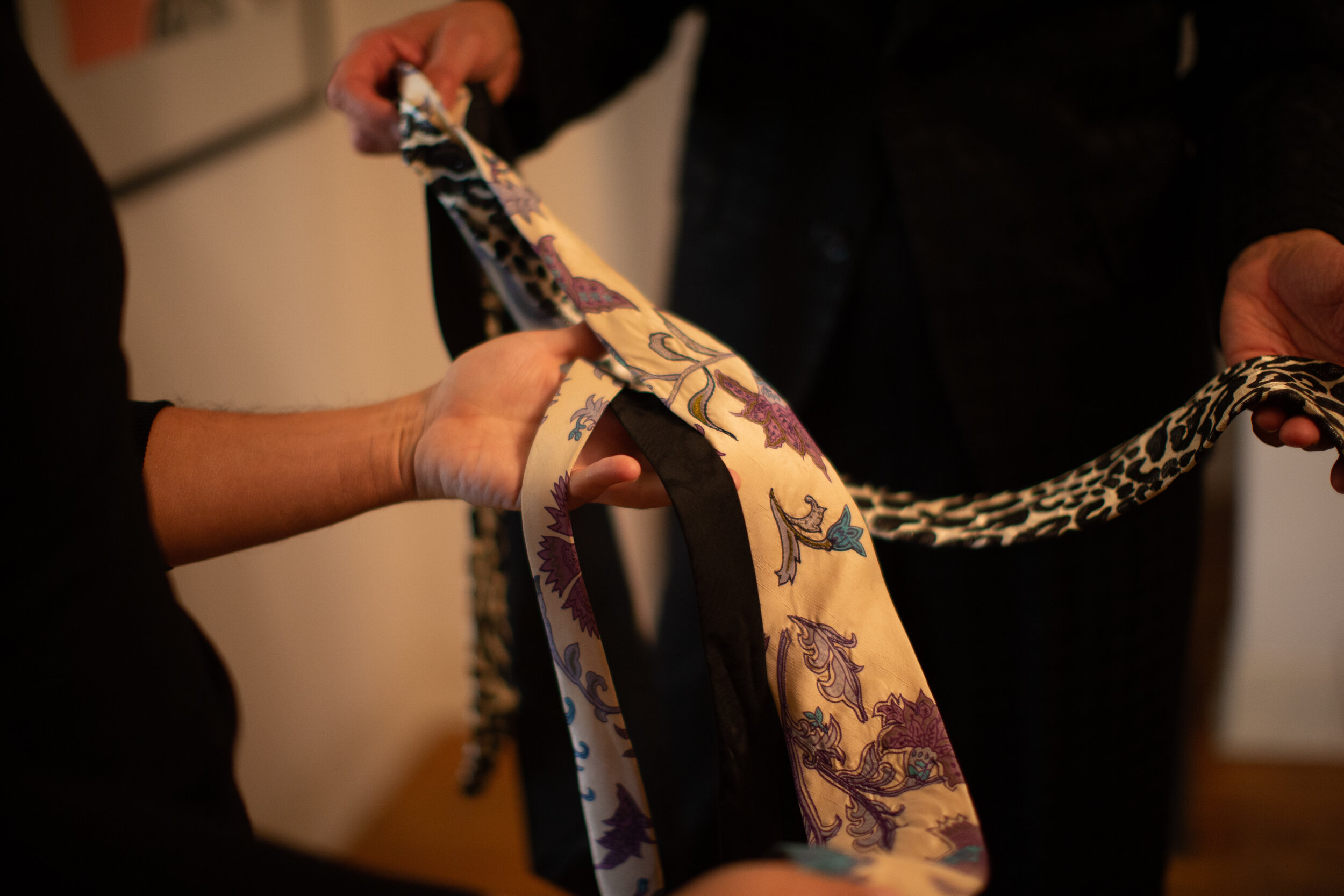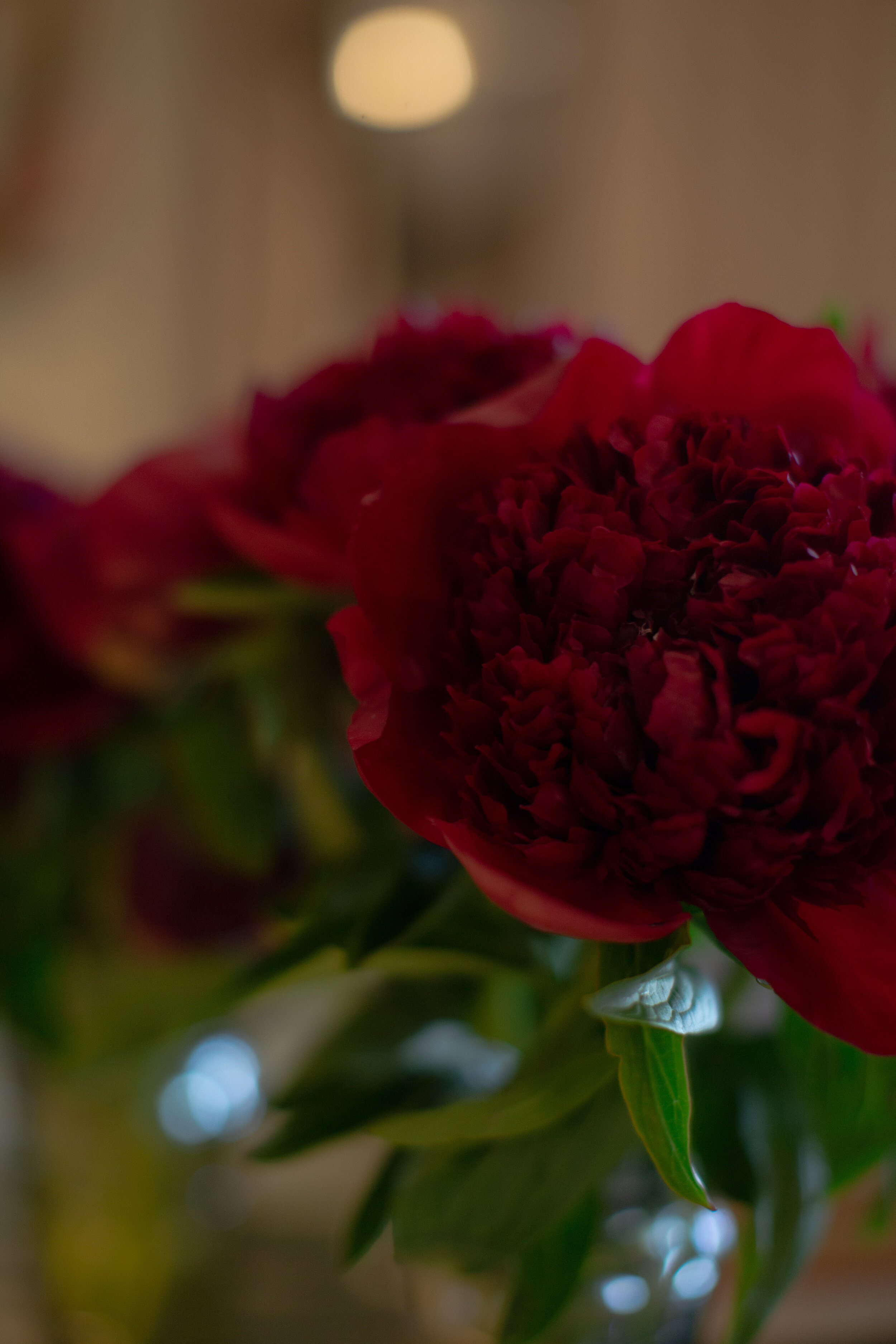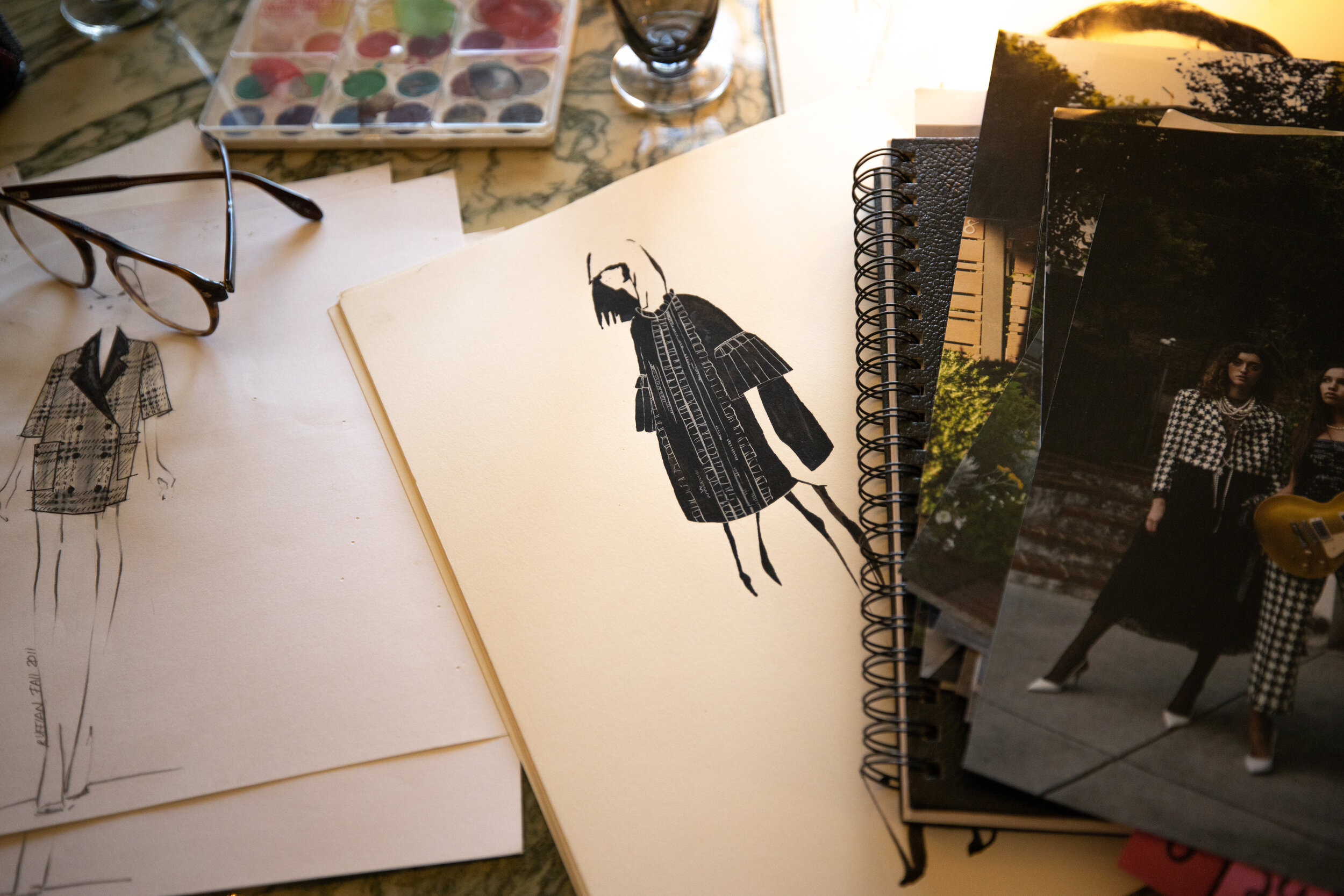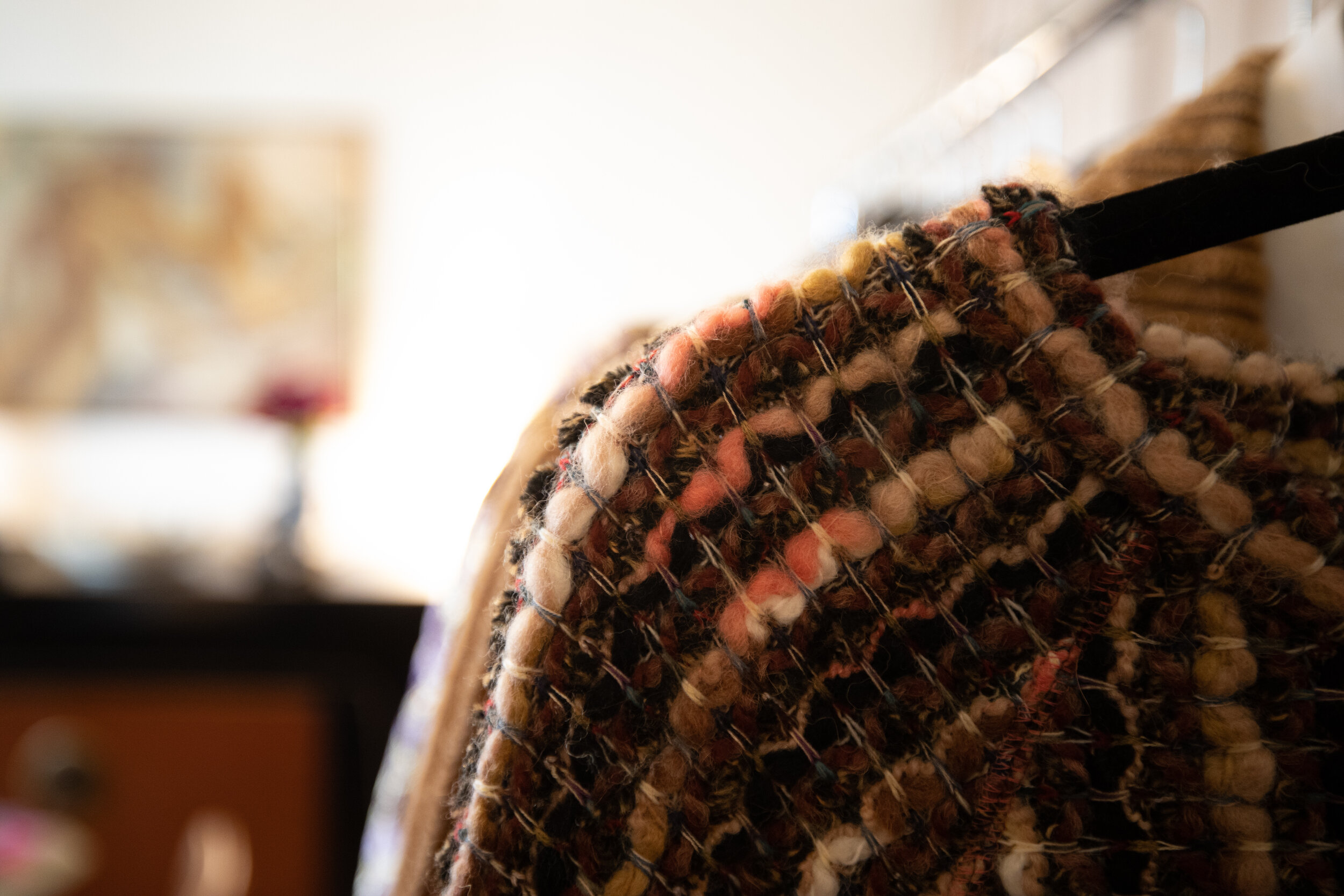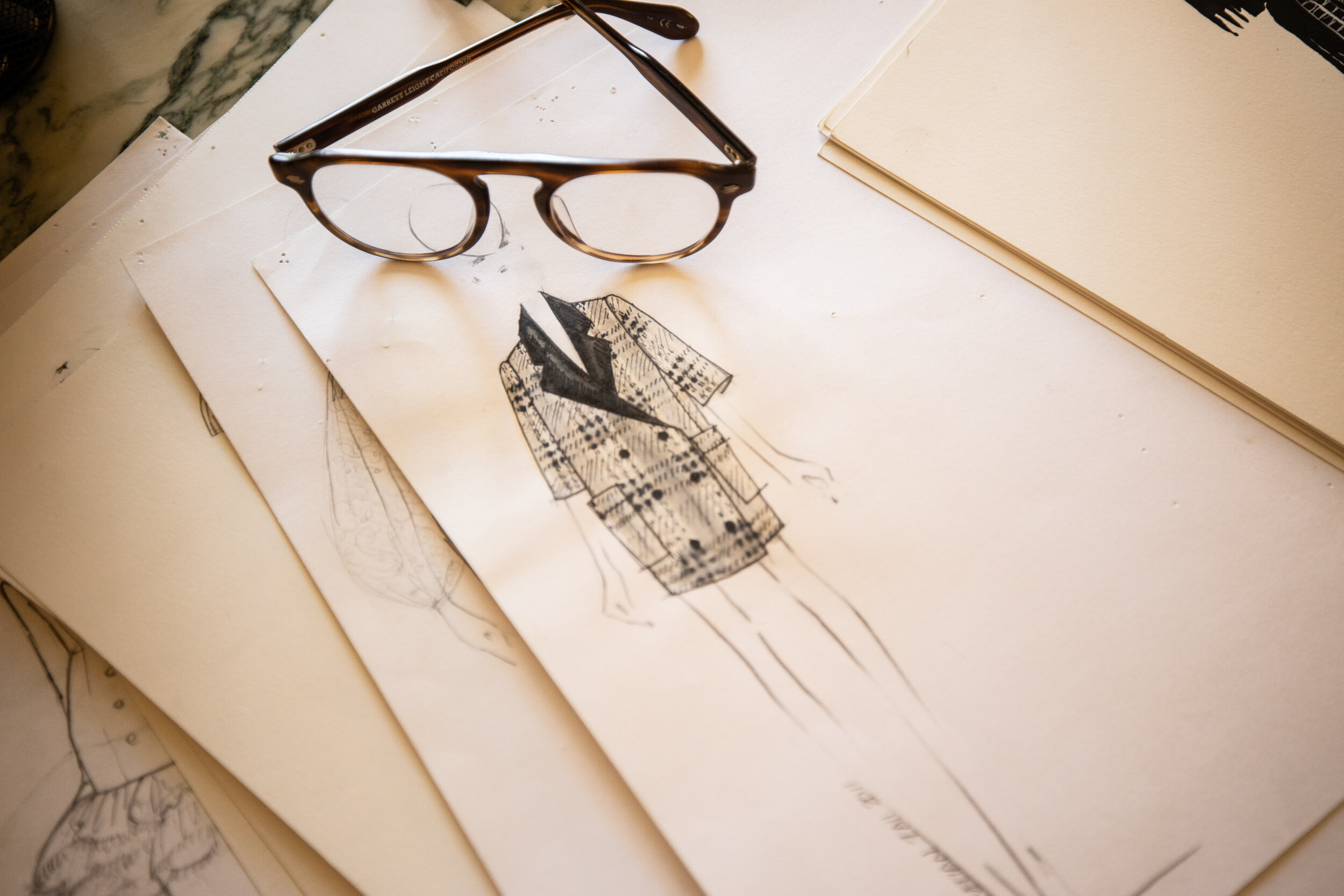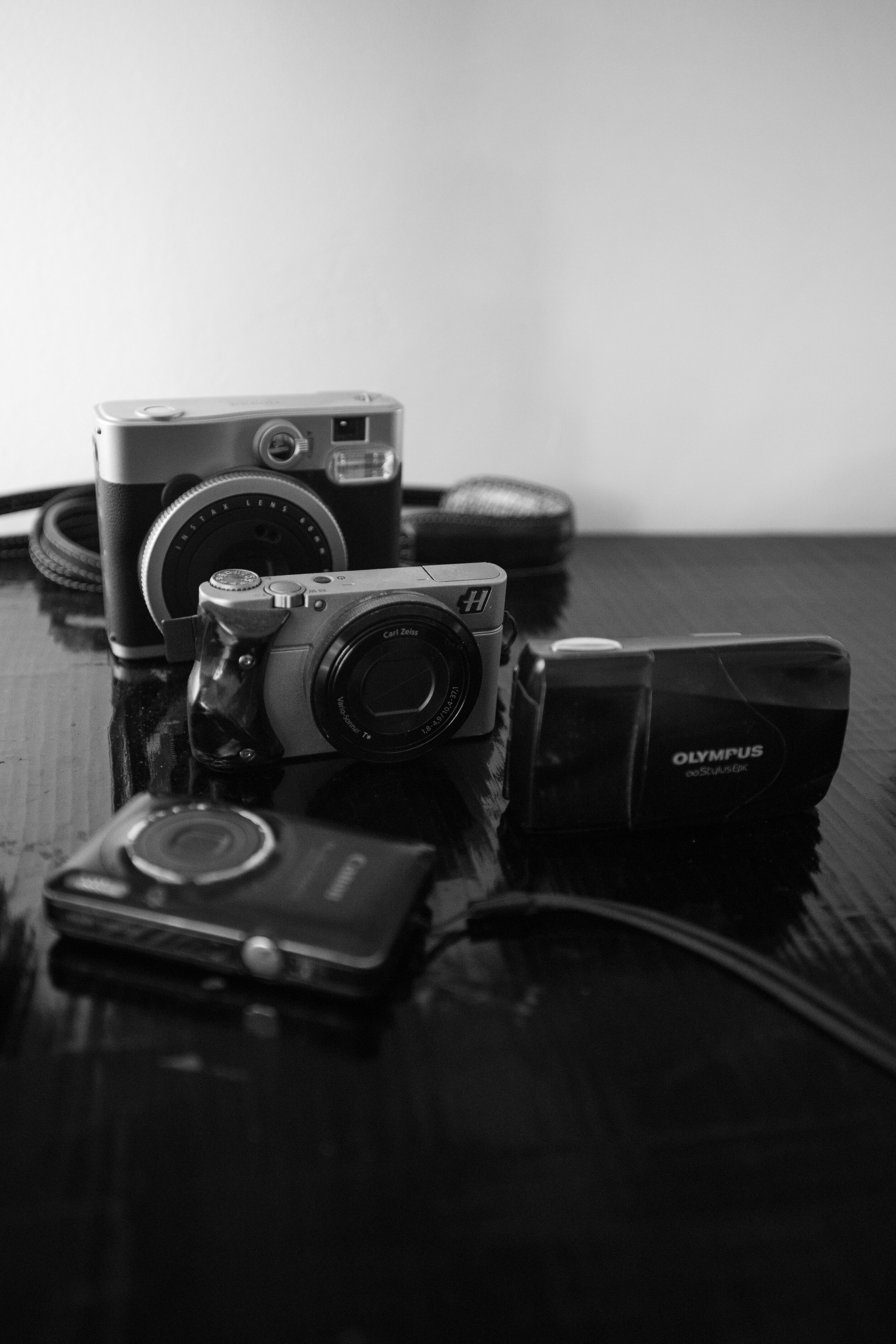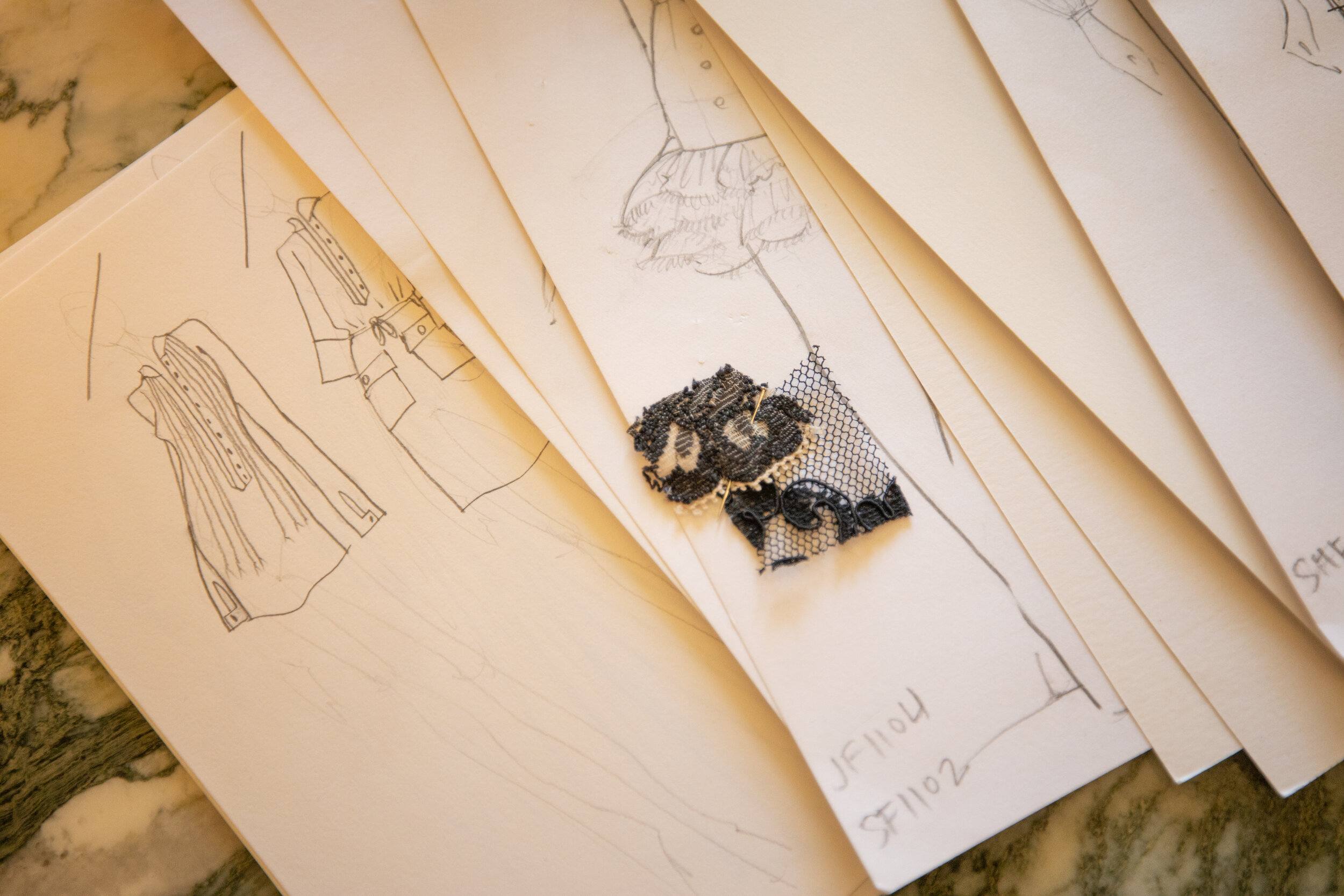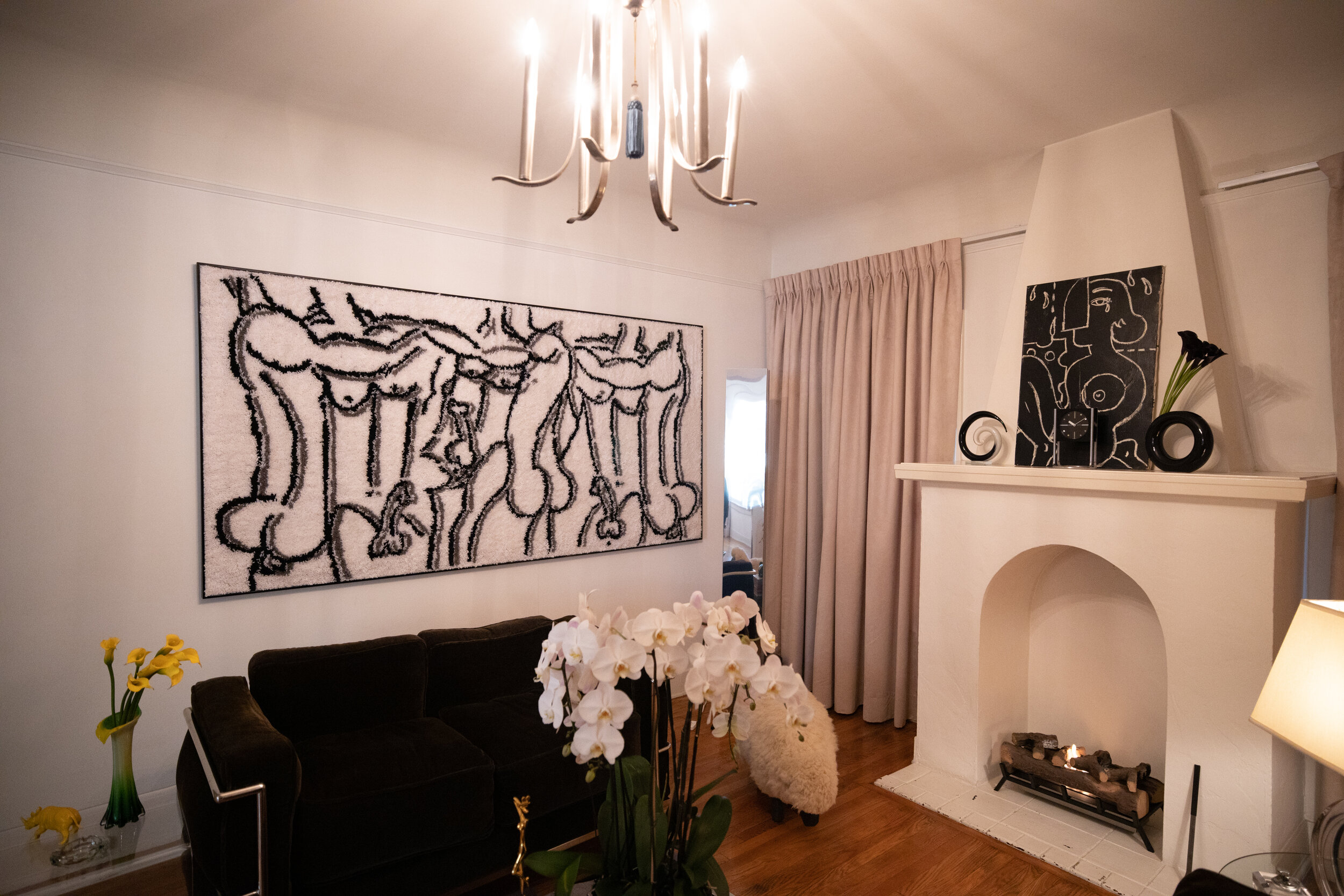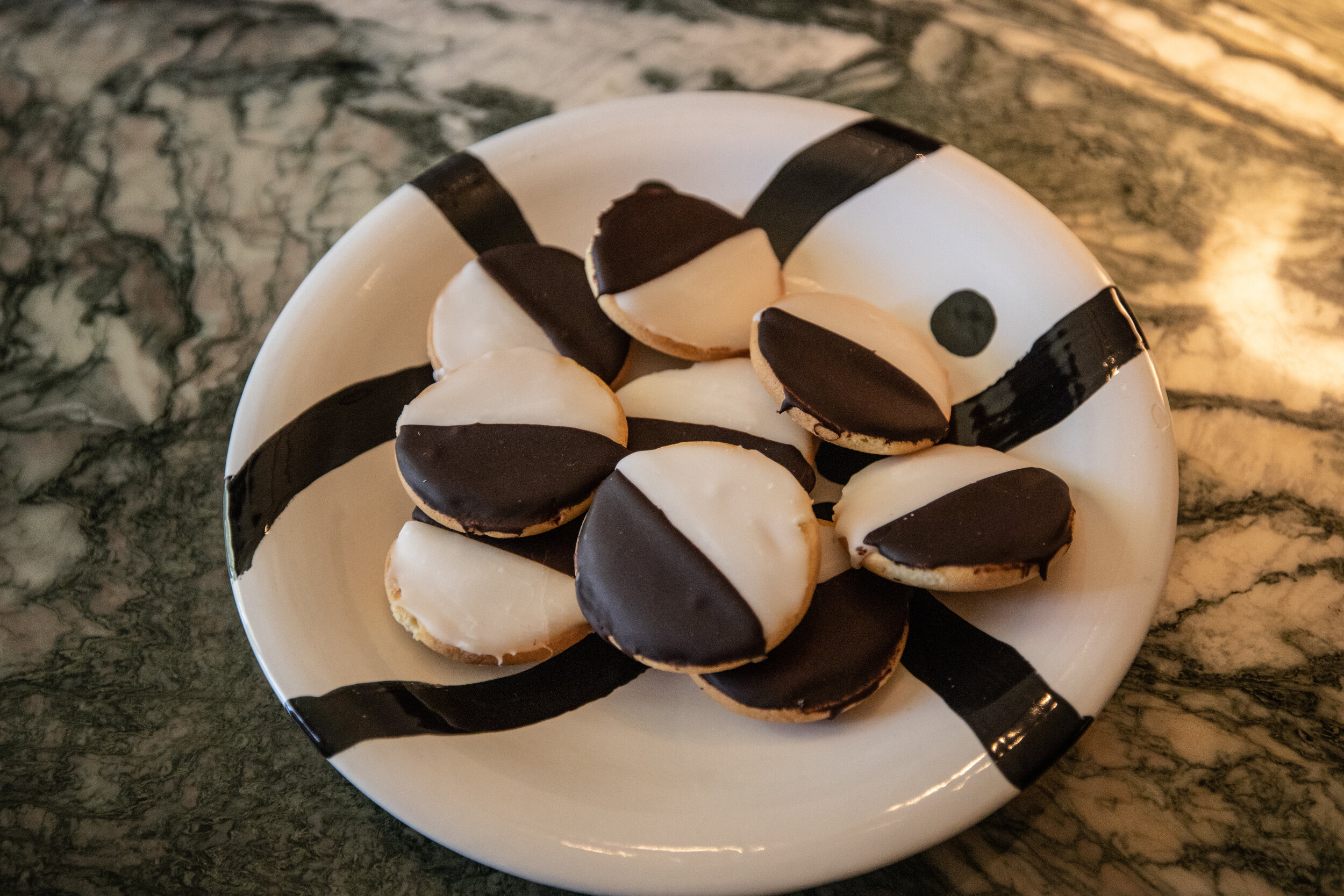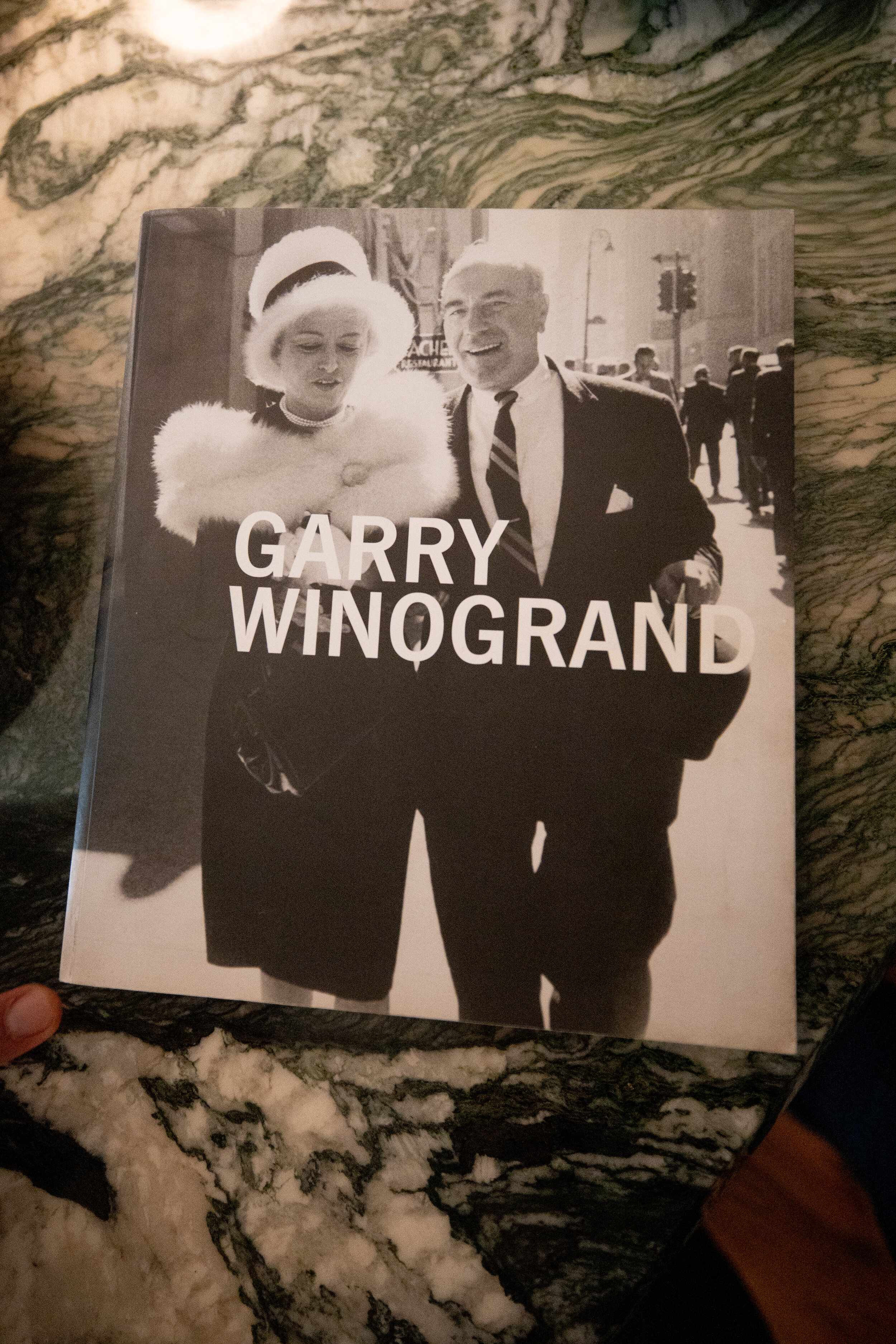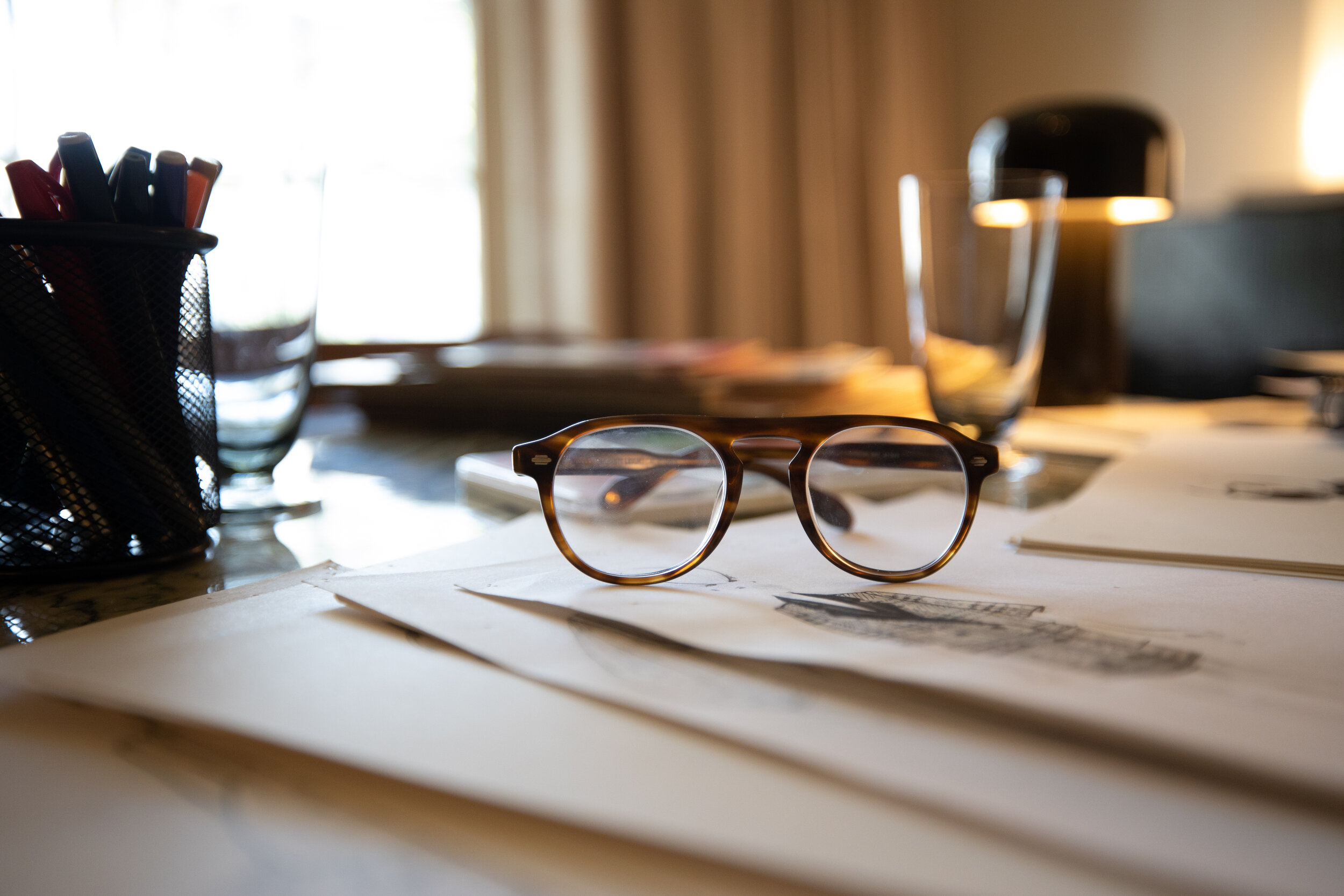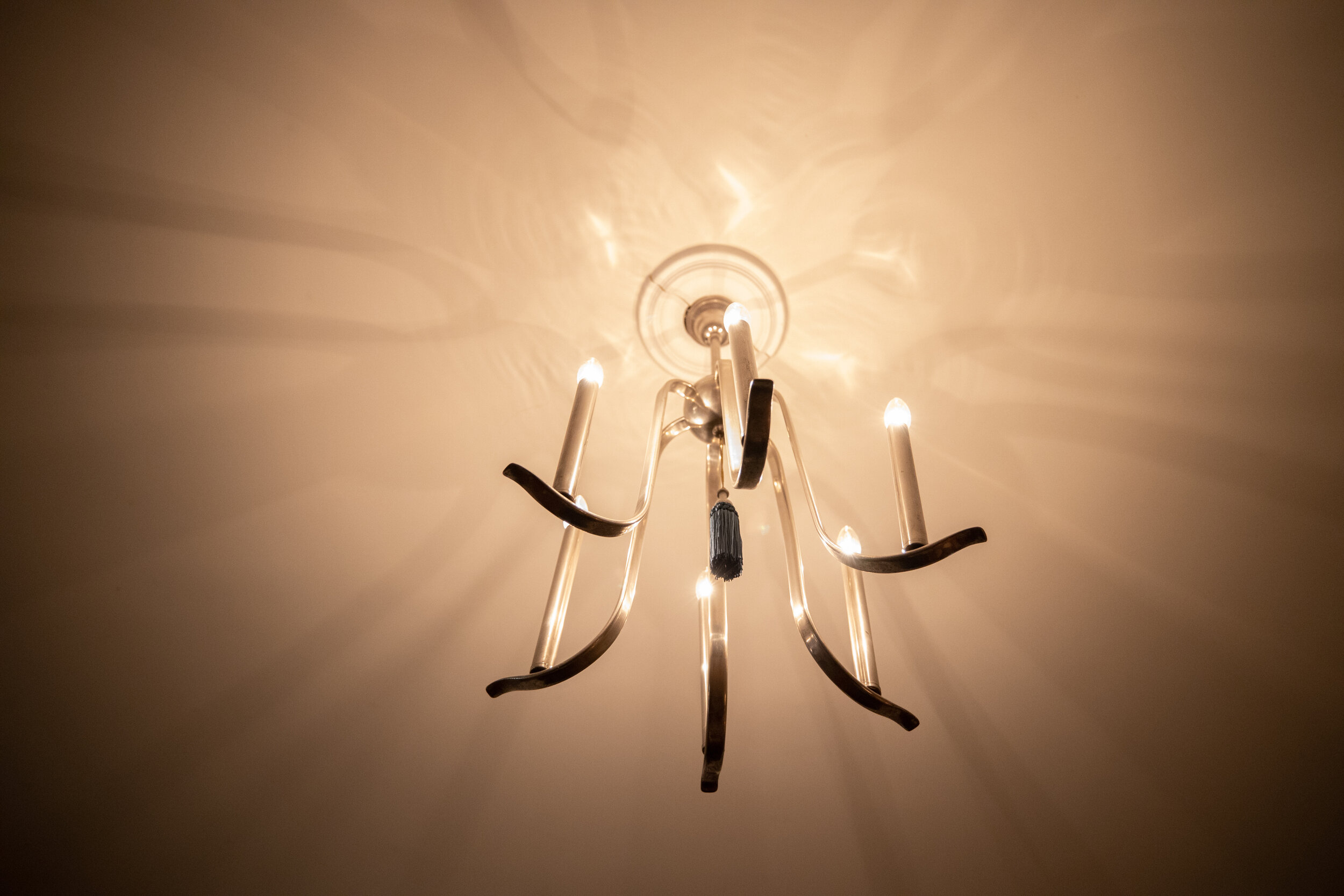Brian Wolk and Claude Morais
The L.A. designers discuss finding inspiration in their West Hollywood cottage.
By Lindzi Scharf
Photography by Kate Jones
Seven years ago, designers Brian Wolk and Claude Morais traded their Williamsburg, Brooklyn loft for a West Hollywood cottage. And they haven’t looked back. The former New Yorkers – who previously designed under the moniker Ruffian – traded couture ties, edgy collars, and the Lincoln Center for women’s suiting, tweed, and runway shows at various Hollywood landmarks.
“We were, frankly, one of the first [designers] to leave New York,” Wolk says, seated at a marble table inside the duo’s West Hollywood home. “I love New York and I’m a New Yorker, but New York Fashion Week felt really archaic at that point. I felt like we did whatever we could do, but it was time to move on.”
HELLO, LOS ANGELES
Morais and Wolk first entertained the idea of Los Angeles when they presented Ruffian’s West Coast-inspired Spring 2015 collection, which showcased 25 monochromatic looks including a silk crepe dress and text print ties with typography by artist Maynard Monrow. Held in collaboration with the L.A. Tourism & Convention Board, the runway show, which was styled by Elizabeth Stewart, featured designs that were conceived, sourced, and sewed exclusively in Los Angeles using local resources and manufacturers.
“When we left New York, we made a commitment to embrace the culture of Los Angeles and to fully explore it creatively and aesthetically—whether it was architecture, design, cinema noir, pre-Code films,” Wolk says. “There’s always been amazing, iconic Los Angeles designers. We’re obsessed with [James] Galanos. We’re obsessed with Edith Head and all of the studio designers. They’re always part of our repertoire. When we moved here, we said, ‘We’re going to create an L.A. brand that’s inspired by L.A.,’ and we’ve never diverged.”
At the time, breaking away from the New York Fashion Week calendar proved to be a particularly rebellious move – as very few, if any, designers had previously done so. While there wasn’t a playbook for their next move, the duo strongly felt it was the right choice for them personally and professionally.
“After our last fashion show at Lincoln Center [in 2014], we had been flirting with the idea of moving to Los Angeles,” Wolk explains. “We took a fiercely planned road trip.”
“With trunk shows along the way,” Morais adds. “We had our collection in the car. I drove 3,000-something miles.”
“It was Atlanta, Dallas, New Orleans.”
“You made me do a 600-mile detour to go to Santa Fe.”
“Oh, and we visited Marfa!”
“This idea of a road trip is something that we’ve always had in our relationship,” says Wolk. “We used to drive to Montreal together, but since then it’s really become part of our creative process. Road trips have become a vehicle—which is a funny double entendre—but they’ve become a vehicle for us to step back and think and process and have a creative moment. So that’s how it started—with a road trip to Los Angeles.”
THE BIRTH OF WOLK MORAIS
Once Morais and Wolk officially committed to the move, they decided to launch a new line: Wolk Morais, a reflection of their newfangled west coast sensibilities. They held their first WM Resort 2016 runway show a year later at Los Angeles’ Kohn Gallery where guests were greeted by a Technicolor carpet and the models wore bright ensembles including an orange calvary twill bow tie dress, a green silk coat, and a yellow calvary twill bow evening gown with a silk georgette skirt – a clear departure from the designers New York once knew. The models’ hand-sculpted brontosaurus fascinators, created by Monetz of The Millinery Guild, added a cheeky touch driving the point home.
Hollywood quickly embraced Wolk Morais. Julia Roberts, Viola Davis, Blake Lively, Katy Perry, Janelle Monae, Jessica Chastain, and Kendall Jenner are among those who have worn the label’s designs. Having released their ninth collection in September of 2020, the designers held runway shows at Hollywood hotspots all over town including Yamashiro, the Hollywood Roosevelt rooftop, Harlowe, The French Market, and Giorgio’s Night Club at The Standard Hotel in West Hollywood.
“The location always inspires the collection,” Wolk says.
More recently, Wolk Morais branched into short film presentations in lieu of runway shows. “We love to do fashion shows, but Los Angeles is a town where film is the medium and film is the language,” Wolk says. “After doing all these runway shows inspired by film, we were like, ‘Maybe it’s time for us to start making some films.’ For the last couple of films, we’ve been interested in exploring our talent and what their lives are like and how clothing affects them, but sometimes the films are just about them. It’s not always about the clothes.”
THE CHALLENGES
While Wolk Morais is popular among Hollywood’s best dressed, that’s not to say the road to success has been without its challenges.
“The struggle is real,” Wolk adds. “It’s challenging to work in fashion in this day and age.”
“It’s competitive,” Morais adds.
“You saw the Halston docu-drama, right? It’s always been competitive…”
“And why a dress doesn’t make it versus another dress? There’s only so much Brian and I can do. We’re in our bubble [creating], but I think the challenge is always to pass on the message. We celebrate when we have a success.”
“You really do have to celebrate the successes,” Wolk agrees. “You also have to be relentless in your direction and in your aesthetic. I do think that as soon as you try to start placating the needs of others or you start doing things aren’t intuitive to your aesthetic or lifestyle…”
“…like doing a travel-leisure collection. No. I don’t want to do that. Even if the fashion world decides what we do is ‘not in fashion’ we still have to do it because it’s us.” Morais pauses. “But that’s hard.”
AN ISOLATING EXISTENCE
Morais and Wolk both acknowledge that the life of a designer can be an isolating existence. “Fashion is a lonely business,” Wolk says. “There isn’t much camaraderie amongst designers. I don’t think that’s a secret. I always see our actor friends or our other friends and they all hang out together and they do things together. At least on the surface, it appears that way.”
“I’m friendly with everyone,” Morais says. “We see each other at Giorgio’s and we say hello; we dance together; or they come here sometimes after Giorgio’s and I’m a bit nervous. I think, ‘Should we invite him? Okay. Why not? Who cares? He’s not going to copy anything. There’s nothing to copy.’ But when you’re competitive—”
Wolk interrupts: “We’ve had designers who were mentors that were older and way more established.”
“That’s different.”
THE BUSINESS OF FASHION
Morais and Wolk also say that the world of fashion is a constant learning curve. “The business is complicated,” Wolk says. The buyers are complicated. It’s always someone’s opinion.”
“Brian always says, ‘It’s the story of a dress, a blouse, or a jacket. Who wore it, why, when…’” Morais adds. “It’s fascinating.”
As a result, Morais and Wolk have begun focusing on small batch collections and custom creations fashioned from upcycled fabrics. “Everything we do is within twelve miles of our studio,” Wolk says. “All of our samples rooms are here within practically walking distance – except for one in the Valley. Sometimes we hand carry stuff.”
“Sometimes we find ten yards, but ten yards is enough to do a small production,” Morais says. “You can do five pants, two shirts. If someone is dying for that tweed, I can say, ‘We’re out of it, but I can find a similar fabric. If you want that, it’s sold out.’ It’s almost like a weird hybrid of our own couture and bespoke designs. We’ll do a suit and if a friend comes here and wants that suit but she has a beautiful silk, I’ll say, ‘Okay, we’ll make you a suit with that silk in our shape.’ That’s the language. It’s hard because we don’t produce a hundred and fifty-five sweatshirts that are globally distributed.” He pauses. “I feel like here in America there’s no word that really expresses what we do… It’s not made-to-measure. Bespoke is the word, I think. But sometimes bespoke is [specific to] menswear. But I like bespoke because sometimes couture sounds—”
Wolk chimes in: “Farty.”
“And haute couture is only in Paris. So you can’t call it haute couture. It’s not. I can lie to myself, but it’s not.”
Another challenge for smaller designers is that each piece has a short shelf life. “If a celebrity wears an outfit, it’s done,” Morais explains. “No one can ever wear that suit again. We have to live with that.”
“We have to retire it,” Wolk clarifies. “Not retire it for sales, but no other celebrity can wear it again.”
The pieces are put in storage. “We can sell it to someone, but that’s it,” Morais says. “Unless Vogue or Bazaar wants to shoot it for an editorial with a model, [it can’t be worn again.] That’s what designers live with. You know ‘Who Wore It Best?’ That’s fun for the gossipy, but that’s a no-no for the stylist. They get upset.”
While larger brands and companies can afford the occasional misstep, Wolk says the rules are much stricter for independent designers who want to maintain solid relationships. “We’re too small to make mistakes,” he says.
“Bigger companies, yes, they can do that,” Morais adds. “They can find an excuse, ‘Oh, we didn’t realize.’”
Wolk Morais prefers to protect their celebrity clientele—even if it means retiring a meaningful design.
THE HEROES’ JOURNEYS
Before Morais and Wolk met, they were working, separately, in different facets of fashion.
Back in the nineties, the fashion industry felt like a distant dream for Morais who was originally from Montreal. “As a young French Canadian, I wanted to have a career in fashion and was working hard in shops as a shop boy,” he says. “I was struggling. I was working and I got scouted by this young agent. She said, ‘Have you ever thought about modeling?’ I was like, ‘No. I’ve never really thought about that.’ She said, ‘Let me take some pictures of you.’ I got a contract [in Japan] and left and then the world opened up to me. It was the first time I left my hometown and then I never went back to be honest. I met friends.”
Morais continues, “From Japan, I kept modeling and went to Milan, then Paris. Being French Canadian, I stayed in Paris and worked in a restaurant part time because modeling was not always paying the bills.” Eventually, Morais transitioned from modeling to styling in New York.
In the meantime, Wolk was on a different path within the same industry. Born and raised in Westchester, New York, he studied fashion and costume design for theatre at the Fashion Institute of Technology. From there, Wolk worked on Broadway and at the Santa Fe Opera. “I was an assistant costume designer on Broadway,” he clarifies. “I wasn’t designing Broadway shows at 18. I worked for a famous costume designer named Ann Hould-Ward, who is legendary.”
From there, Wolk transitioned from costume design to working in fashion. He created Elizabethan collars that he sold to Barneys as a side hustle. He also spent time in Paris creating accessories for Virginie Viard at Chanel during the Karl Lagerfeld era. “I was there on and off for a year and a half,” Wolk says, explaining he moved back to New York and met Morais soon after.
“We worked for a designer named Maggie Norris who is a couturier and used to be the head of Ralph Lauren,” Wolk says. “I worked for her and then Claude worked for her when he was styling.”
But that isn’t how they met.
THE MEET-CUTE
The story of their meet-cute differs depending on the time of day and which one of them you ask. On this occasion, a morning in late May, the duo prove to be especially loose-lipped.
“Well, there’s the real story…” Wolk says with a laugh. “And there’s the press story…”
Morais returns to the room after changing into a different head-to-toe ensemble. “Before you talk about how we met, did you talk about our love for France?” he asks.
“I’ll get there. I said I worked at Chanel and for Maggie. I lived in Paris. We both love Paris. Obviously, everyone loves Paris. Does anyone not like Paris?” Wolk says, laughing. “Anyway, circling back: The press story is we met at an event at the National Arts Club on Gramercy Park because I was a member. The real story is we met at a bar in the East Village. It was a late Monday night on December 4th a hundred years ago. We met [when I was] 20. The funny thing is that for the first month and a half of dating, Claude refused to tell me what he did, which was so weird. I’d always be like, ‘What do you do?’ I knew he was kind of creative. I knew it had something to do with clothes.”
“I was like, ‘What do you care?’” Morais says. “We were just hanging out.”
“So we met at a bar and then a week later I asked him on a date to the National Arts Club on Gramercy Park for a [Marcel] Proust reading,” Wolk says. “That’s the press story.”
Morais chuckles. “Maybe the truth is better.”
“Because he wouldn’t tell me what he did, I said, ‘Do you have a suit? Because there’s a dress code at the club,’ and he was like, ‘Of course I have a suit. So he met me at the club and we had dinner and we went to the Proust reading.’ And then finally, a month and a half later, he told me, ‘I’m a fashion stylist.’ Then basically we were dating and I was working for Maggie and Claude started styling for Maggie doing all her shows.”
“We worked with her after she worked with a big company, so we really saw how to do it from scratch.”
“She headed up Ralph [Lauren]’s collections for twenty-five years and then started her own company.”
“That was huge. That’s how we started working together.”
“While we were working with Maggie, we did a side hustle. Under Ruffian, we started using couture fabrics to make men’s ties and couture collars, which was my background at the time. Eventually we did a collection of clothing for Ruffian called Collars & Dresses. We did Ruffian for a decade and then we moved here.”
“That was almost twenty years ago.”
THE RIGHT FIT
The journey from dating to collaboration was organic.
“We’re both creative,” Wolk says.
“We have a connection,” Morais adds. “When you’re a duo, one helps the other for the best and for the worst, you know? Even if you’re a single designer, I think every designer has a right arm, who is sometimes anonymous and never talked about and works as hard. When you’re a duo, you share those things. You share the worries. We love that vibration. We create with it.”
Both creatively and personally, Morais and Wolk have much in common – including a passion for food. “We love the same foods,” Morais says. “You don’t want to be with someone who doesn’t like your food. I cook for him. He cooks for me.”
Wolk interjects: “I had a brief vegan moment two years ago…”
“We almost broke up,” Morais says.
“Not really.”
“But it was the ultimate test. It was three months of veganism and I supported it. When we were on vacation it was easier for me. I didn’t care what he ordered at a restaurant, but when we came back to real life, it started to be like, ‘I need to do my chicken and I’m going to cook you your vegan…’ I was like this is not going to work anymore. I’m sad to say it to you, but if we don’t eat the same food, it’s going to be a problem.” Morais laughs. “If you’re vegan, find a vegan partner. I’m sorry. Life is hard. After this ultimatum, I agreed that we would avoid the most meat possible.”
“We eat vegan food fifty-percent of the week now,” Wolk says.
LOCKDOWN LIFE
Over the last year, Morais and Wolk used their time during quarantine to get creative in new ways. Having completed their ninth collection, the designers shot a socially distant film to celebrate its release. “It was inspired by the idea of isolation,” Wolk says, explaining they drove around town capturing footage of various talent – including stylist Elizabeth Stewart and her son in coordinating purple suits as well as model/actress Lydia Hearst dripping in pearls and black lace – outside their homes.
“It forced us to work in a different way,” Wolk says. “But the idea of being home in Los Angeles is part of the culture way more than New York. In New York, people go home for two seconds after work and in between going out. In Los Angeles, being at home is a lifestyle. [We liked] the idea of going to people’s homes and traversing the city. There are so many tribes in Los Angeles: the east side, the west side, the Valley; people really identify with their neighborhood here. It put us on a road trip for twenty-six nights.”
“Thank God, I love driving,” Morais jokes. “Our old vintage car—she made it. … We would bring the look and give the talent thirty minutes to change. It was luck that everything fit. They did their own make-up and hair, so we avoided all of the extra people because we were in the thick of the pandemic.”
“It was just us and our [director of photography],” Wolk says. “We would arrive every night at six, the magic hour, and we would shoot them in front of their house and do a video portrait. We created this poetic, moody piece that was able to show our collection.”
The duo also worked remotely on a few interior projects for friends including Stewart and Air Mail design director Angela Panichi. While the opportunities allowed them to stretch their legs in new ways, they say the process is ultimately an extension of their love of materials and aesthetics.
Morais and Wolk admit they weren’t in a rush to complete their next collection. “It was difficult for us to begin our next collection,” Wolk says, “because we didn’t know what the world was going to be like and I think as a designer part of your job is to understand the zeitgeist and be able to create in the moment. During the pandemic, it was almost easier to create the collection because we knew what was going on and we could touch it. For me, creatively now, I feel like–”
“It’s a crossroad,” Morais says.
“I didn’t want to design athleisure clothes because I’d rather die.”
“Working on Elizabeth’s home during the pandemic, fixing our house, and doing Angela’s home in New York was a great creative relief.”
WHAT’S NEXT
With the country slowly rebounding from the pandemic, Morais and Wolk have turned their attention to their label’s next collection and next film. “That’s the job—the next thing,” Morais says. “It’s always unfortunate because even when we do the next thing, sometimes, we get trapped into the thing after the next thing even as you’re working on the current next thing.”
However, the designers insist they will no longer pressure themselves into producing pieces solely in the name of the fashion calendar.
“We can be better because we don’t follow and we’re not victim to this fashion calendar that is demanding when you’re a smaller designer,” Morais says. “We do what we want. We show two times a year and we skip all the in between collections because ultimately people are still borrowing and wearing the previous collection.”
“The fashion calendar is really, really archaic,” Wolk agrees.
“We’re lucky,” Morais adds. “We’re kind of rebels. Bigger businesses have to follow a certain delivery. How do you change that? I don’t know. It’s more than one designer at a time.” He adds, “We don’t want to stress ourselves. We’ve been there before. That’s what we changed in our lives.”
HOW THEY LIVE…
“The cottage’s history is that it’s been here since 1919,” Wolk says of the couple’s West Hollywood bungalow. “It was built for the studios down the street. All of these cottages were for make-up artists and costume designers. Charlie Chaplin’s building is nearby.”
“It was built for employees and for artists that would need to get away for the night or to live nearby the studios,” Morais adds. “It’s really the heart of Hollywood. … We made an effort when we moved here to live as minimally possible.”
“Our Williamsburg space is the polar opposite of this space,” Wolk says. “There, it’s very New York. Here we really wanted to embrace the modernism and freshness of California. We sourced pretty much in Los Angeles—with the occasional eBay item.”
“Our entire home is sustainable,” Morais says. “There’s nothing new except for gifts from friends. That was a commitment that we had – to make it look of the moment and modern and new, but it’s not.”
THEIR OFFICE
“This is our daytime workspace/lunch space,” Wolk says. “It’s where we have meetings. … We still have our place in Williamsburg, but we didn’t want to move all of our furniture from Williamsburg here. We wanted a fresh start, so we ended up finding this place and when we moved in, there was nothing. Literally we had a bed and we just camped out. It was completely empty. Very rarely in life do you have a true fresh start where you can move into a place and have nothing other than a few pieces of clothing and start from the beginning.”
“It was a great exercise,” Morais adds. “We would sit on the floor until we found the right sofa. It took a couple months, but things came through.”
MORAIS’S HAND-PAINTED PLATES
“I do pottery and ceramics,” Morais says, explaining he likes to go Color Me Mine. “Of course, when I do my erotica, I’m not next to a five-year-old. I’ll go and do a set of 12-18 plates.”
Wolk adds, “Claude takes over the whole table and lays out fifty plates and starts doing it. Usually we go when no one is there.”
“All this was done in Grand Rapid, Michigan,” Morais says. “We were at a trunk show. I was a little bit impatient, so Brian was like, ‘How about you go take a walk in the mall?’ So I go take a walk in the mall. I was there an hour. Brian was like, ‘Where are you?’ I said, ‘I saw this shop and I’m painting.’”
“Meanwhile, I’m dealing with every client in Grand Rapids while he’s painting plates.”
“I did a set. I did a wedding gift for friends. I did plates. And then they have to cook it, so they baked it and then they shipped it back to us in Williamsburg from Grand Rapids, Michigan and that was the beginning of me doing this. But then, when I see a Color Me Mine—I always try to stop by and do a teacup.”
THE MARBLE TABLE
“I’ve always wanted to have a great dining room table,” Wolk says, referencing their Italian Polar Verde marble table. “We never had one in Williamsburg. We found it on Craigslist in North Hollywood. I saw it online and was like, ‘This is too good to be true.’ It’s a very particular grain Italian marble that we miraculously found.” Nearby sit 1970s Chromecraft wood and leather Intrecciato Cantilever chairs.
THE LAMPS
“We adore these lamps,” Wolk says of a pair of Edward Barber & Jay Osgerby Flos bellhop table lamps. “They were a housewarming present from Bryan Rabin. We saw them at his house and we became obsessed with them.”
THE RECORD PLAYER
“This is my most precious item,” Morais says as Madonna’s “Lucky Star” plays on his Magnavox 1965 portable record player. “We found this on eBay fifteen years ago. I didn’t believe it would work. They said it was in impeccable condition, but I thought by the time it shipped [it wouldn’t be]. I plugged it in and it worked and it still works. This started our life as partygoers in Williamsburg. It took almost four years to move it because I was afraid to FedEx it.”
THE FLOOR LAMP
“We wanted something romantic and kind of sexy that was giving a source of light and then Brian came along this lamp,” Morais says of their Fortuny floor lamp. “It’s classic. I’m obsessed with this shape.”
THE DRESS FORM
“That’s my first dress form from college,” Wolk says. “Her name is Esmerelda. I don’t know why, but she’s always had that name. I got her when I was at FIT. She was a mess.”
“We had to fix her,” Morais adds. “The foot broke when we shipped it to L.A. We found this shop in downtown L.A. that fixed it and made it brand new.”
THEIR FIRST FILM
“That’s from our first movie,” Wolk says. “We started doing films because we wanted to create lives for our clothing. Our first film was a love letter to Los Angeles. We interviewed all of these great people – cool actors, musicians, dancers, motocross riders and we asked them why they loved L.A. It was poetic.”
THEIR BOOK COLLECTION
“Brian had this concept of a wall bookshelf and I’m like, ‘I don’t want a mess,’” Morais says. “The books are in the bedroom. I don’t want people to come over and see all the messy books. What we do is I go shopping [in our bedroom] and I pick my book of the moment. Sometimes you find a book that you forgot about. That’s my trick. A friend of mine told me, ‘When you’re tired of your house, empty the room and re-shop it. Put things where you didn’t expect. Put the bed in the living room. In Williamsburg, he would come home and the bed would be in the living room. I always find my desire to put the bed in here, but Brian’s always like, ‘That isn’t going to happen.’ But for me, I like that because it’s free and it brings excitement and change and that’s always what I believe.”
A VASE BY MORAIS
A vase hand-painted by Morais sits on top of a 1930s black and persimmon deco chinoiserie credenza, which they found at a vintage shop in Los Angeles while exploring the city for the first time. “The credenza was a big decision,” Morais says. “This is also an office, so the computer and printer are in there. If we’re having a party, I throw everything in there. It’s like a squirrel nest.”
A PIECE OF POTTERY
“Lauren Elder is this amazing potter that we met in Los Angeles,” Wolk says. “She made that for us, which I’m obsessed with. It reminds me of Henry Moore, which is one of my favorite sculptors. Her work is beautiful.” Nearby sits a pair of 1980s white torch tabletop lamps as well as a vase and bowl hand-painted by Morais.
GIFTED BY ELIZABETH STEWART
“The painting was from Elizabeth as a gift,” Wolk says of a 1970s piece by Dámien. “It was from her friend Brian who passed.”
“He was a very good friend of hers and an amazing artist,” Morais says. “She always says, ‘You guys remind me of Brian.’”
“She gave it to us as a housewarming gift after our show at the Roosevelt Hotel.”
“We moved in the day after the show. Brian and I did the show and we came here with our two bags.”
“There was nothing here except that.”
“I think a mattress had just arrived. So there was a mattress on the floor because I hadn’t had a chance to put it in the bedroom. And there was this on the wall.”
They decorated the room based on the painting.
THEIR MOST RECENT COLLECTION
“This collection was inspired by the Hollywood barn [where Cecil B. DeMille shot the first hit movie in Hollywood],” Wolk says. “The idea of clothing that people wore on the lot and the juxtaposition of the menswear of the early Hollywood twenties, thirties, the barn, and the whole romanticism of that.”
“And everything is unisex,” Morais says. “Wolk Morais is WM – like women and men. I’ve always loved that. It was always important to us as we develop and start to do menswear that we could wear it and do both men and women.”
THE VASES
“This is a precious gift from our friend Kyle DeWoody,” Morais says of two moser smoked glass vases by modernist designer Josef Hoffman. “They were vases that she had at her home and that was part of her housewarming gift to us. She gave us all our stemware from her house in Trousdale Estate when she moved to Venice.”
VINTAGE MAGAZINES
“I always look for old magazines,” Morais says. “I find sometimes the articles are more interesting than anything we see in fashion magazines right now. They’re articles about theatre and inspiration and parties and ballet. I’m fascinated. I always look for those special binded Vogue, Bazaar, whatever. They’re very hard to get and that’s my passion. I spend hours [reading them]. I found this yesterday. This is a Harpers Bazaar from 1937. And that’s how we work. We went to San Francisco last weekend and found all of this memorabilia. So we dig and I show him things and we talk, we sketch.”
BOY GEORGE’S LYRICS
“It’s funny because this morning I found this book [on my bookshelf] on minimalist fashion,” Morais says. “I went shopping in my home. I went and took time to look at my bookshelf and what we need for today and what we need for inspiration and I opened the book and I found this…”
He holds up a sheet of paper that features a set list written in Boy George’s handwriting.
“We went to a private Boy George show,” Morais explains.
“There were only about thirty people at the concert,” Wolk says. “After I was looking at the list and Boy George was like, ‘Do you want it?’ We’ve been looking for this forever. We’d lost it. Until today. I was pissed at Claude. I was like—‘Where is it?’ We have to get it framed now.”
“Brian was mad at me. We saw him write down his set list. It was a wedding at the Waldorf-Astoria.”
THE LIVING ROOM
“This tends to be where we [convene] pre-Giorgio’s cocktails,” Wolk says.
“Or after Giorgio’s at 2 am,” Morais adds.
The duo’s custom curtains provide a special touch within the space.
“The draping was important to us to bring in an edge of modern,” Morais says. “It’s our favorite fabric.”
“It’s ultra-suede,” Wolk shares. “The French pleat ultra-suede curtains are this weird reoccurring thing for us.”
“French people love to cover doors,” Morais says. “This drapery technique is a thing I learned in my formative years that will always stick with me because it’s such a good trick. When we have parties here, people are always like, ‘Where’s the exit?’ It creates the illusion of a bigger space.”
VIRGIN MARY
“The Virgin Mary is something I did when we found this in L.A. in a little kiosk on Santa Monica near the LGBT Center,” Morais says. “It’s special to my life because I did this during my mom passing away. I dotted it. I like to do all those silhouettes and all those lines.”
INTERIOR DESIGN
“We’ve been working on Elizabeth Stewart’s home for the last two years,” Wolk says. “It’s a massive, fun, intense, great project. We’ve always been interested in interiors. Even under Ruffian, we did a home line for Anthropologie. We’ve done a lot of interior stuff in general on a smaller level, but now it’s been fun to flex our muscles. We didn’t start doing projects for individuals until we moved here. It’s becoming a part of our thing. Most of the people who we’re friends with, we actually work with in one capacity or another. All of them are fabulous creatives who do interesting things. We started [working on their home projects] and those are the kind of people who we want to work with anyway. So that’s how it started and we’ll see where it goes. It’s all really new.”
“Elizabeth has been our godmother of fashion and interiors,” Morais says. “I’m loving it because it’s good to think about where your clothing or your client can live – in a room that’s not the runway or a showroom.”
THE LAMP
“That was one of our first finds when we came to L.A.,” Morais says of a Dorothy Thorpe plexiglass pretzel lamp, which sits upon a Michael Thonet side table. “We thought it was an interesting detail.” Nearby is a Le Corbusier LC2 loveseat. “We reupholstered the entire [thing], Morais says. “We found the antique frame, but we reupholstered them in brown velvet. Sometimes a frame is as expensive as the real thing, so when we [find] those things it’s great because then you customize them.” Wolk says the Latimer Alexander chocolate velvet brown material they used to reupholster the piece was from a previous Wolk Morais collection. “We often integrate fashion textiles into our [interior] work,” he says.
THE ART OF OBJECT
“Our nextdoor neighbor has a vintage collection website called @theArtof Object,” Wolk says, referencing a pair of yellow rhinoceros by Bruno Billio and a yellow murano callas lily vase. “We got those from him.” The duo’s design style is inspired by the Bauhaus movement and aesthetic. “We always try to reflect this minimalistic, industrial, tubular [approach],” Morais says. Nearby is a refurbished gunmetal coffee table, which was originally an ottoman by Milo Baughman.
MORAIS’S ARTWORK
Many pieces by Morais line their walls. “It all started in South Hampton,” Wolk explains. “We went to our friend Kyle DeWoody’s house for the weekend. We went vintage shopping and there was a latch hook set…”
“I did it as a kid,” Morais says. “So when she gave me [a latch hook set] as a gift, it brought back memories of childhood.”
“After he did the initial one, which was skull and bones, he got really hooked onto it,” Wolk says. “I said, ‘Well, you should take your own line drawings and transfer them to latch hook.’ So that’s how that started.”
“When we moved, we wanted something textile and with texture. We always love tapestries and murals, so Brian was like, ‘Why don’t you do that?’ I have a collection of almost twenty now, but this is my biggest,” Morais says, referencing a black, grey, and white wool piece titled Latchhook Mural #8.”
“That was completed during the pandemic. He’s actually sold a bunch too. He did a show just before the pandemic of smaller pieces. But it definitely relates to our work because these studies were used for a show when we did Ruffian in New York and that was a textile that ended up being a textile. So Claude’s work has always been part of our work.”
THE SHEEP
“Kyle DeWoody is actually the one who gave us these Lalanne [inspired his and her] sheep,” Wolk says. She’s a great collector and a great friend.”
THE SKYSCRAPER TOWER
“We found it in North Hollywood at a vintage store,” Wolk says of a 1970s vintage Castella chrome steel skyscraper lamp. “That was a fun find.” Of curating the items in their home, Morais says, “It’s always an editing process. It’s editing yourself and editing the objects.”
“Claude is famous for doing that when I’m not here,” Wolk says. “I will go to the gym for an hour and a half, or literally just take a shower, and I’ll come back and the furniture is switched around; something is missing; something’s put somewhere else. It’s funny. We’re opposites in terms of astrologically and in general. We’re really opposites. I would just leave things forever and Claude switches things around.”
THE CHANDELIERS
“This was a long challenge because we were looking for twin chandeliers that would connect the two rooms,” Wolk says of a pair of late 1920s Bauhaus chandeliers from Vienna. “It’s impossible to find a pair of chandeliers.”
“The people who sold this to us told us they were in a double room situation, so that’s why they were perfect,” Morais says.
THE ASHTRAY OBSESSION
“We have an extensive ashtray collection even though we don’t allow smoking in the house,” Wolk says. “Sometimes we steal them from hotels and then sometimes we buy them—depending on where they are.”
“We have them from gay bars – Julius in New York, Café de Flore in Paris,” Morais says. “I swiped a couple. I’m guilty, I’m guilty, sorry. I bought some too.”
THE CLOCK & CHRIS LEE PAINTING
“This is a Seiko chrome 1970s mantel clock,” Wolk says. “I’m obsessed with it. It was a gift from our friend Angela when we moved in here. We’re actually doing her place. We’ve been having a lot of fun with her because we’re practicing what we’ve done here with her home in New York.” Behind it is a painting by artist Chris Lee. “This is from my first apartment ever in Williamsburg,” Wolk explains. “I used to live in this big industrial, artisan residence loft and once a week, before I met Claude, we used to have art salons. Chris Lee was one of the first artists we showed. And it’s funny because it has a remarkable similarity in terms of form and function to Claude’s work, which is funny.”
THE AWARD
“We won Best Fashion Film at the London Fashion Film Festival,” Wolk explains. “So that’s one of our prized possessions.”
PERSONAL STYLE
“I undress suits and I dress my jeans,” Morais says. “I’m always in a tie, shirt, and jeans. So it doesn’t look too casual. And then suits, I like to dress them down. It makes it more sexy and California. Dress up your jeans. Dress down your suit.”
THEIR ORIGINAL RUFFIAN TIES
“This was one of our first ties we did for Barneys,” Morais says. “We kept doing them and we repeated them for the new collection in L.A., but we always used couture or luxury fabrics that are unusual for ties.”


